
Create a Simple Clock Illustration
In the following tutorial you will learn how to create a simple clock illustration in Graphic for Mac.
For starters you will learn how to setup and simple grid, how to create the main shapes and how to easily center them. Using two tiny paths and some neat rotation tricks you will learn how to create the clock grid.
Finally, taking full advantage of the Effects pane, you will learn how to add shading and some sleek highlights for your shapes.
Step 1
Go to File > New (Command + N) to bring up the New Document window. Select the Grid document style, set the document units to pixels, and set the document dimensions to 600 pixels wide by 600 pixels high.
Next, we'll set up the document grid. Switch to the Grid pane in the Properties panel. If the Properties panel is not currently visible, you can easily open it using the ruler icon that lies above the Layers panel. Change the grid X Spacing and Y Spacing to 5, set the Subdivisions to 0 and enable Snap to Grid (Command + Shift + ').
Keep in mind that you can quickly enable or disable the grid and the Snap to Grid feature using the Command + ' and Command + Shift + ' keyboard shortcuts.
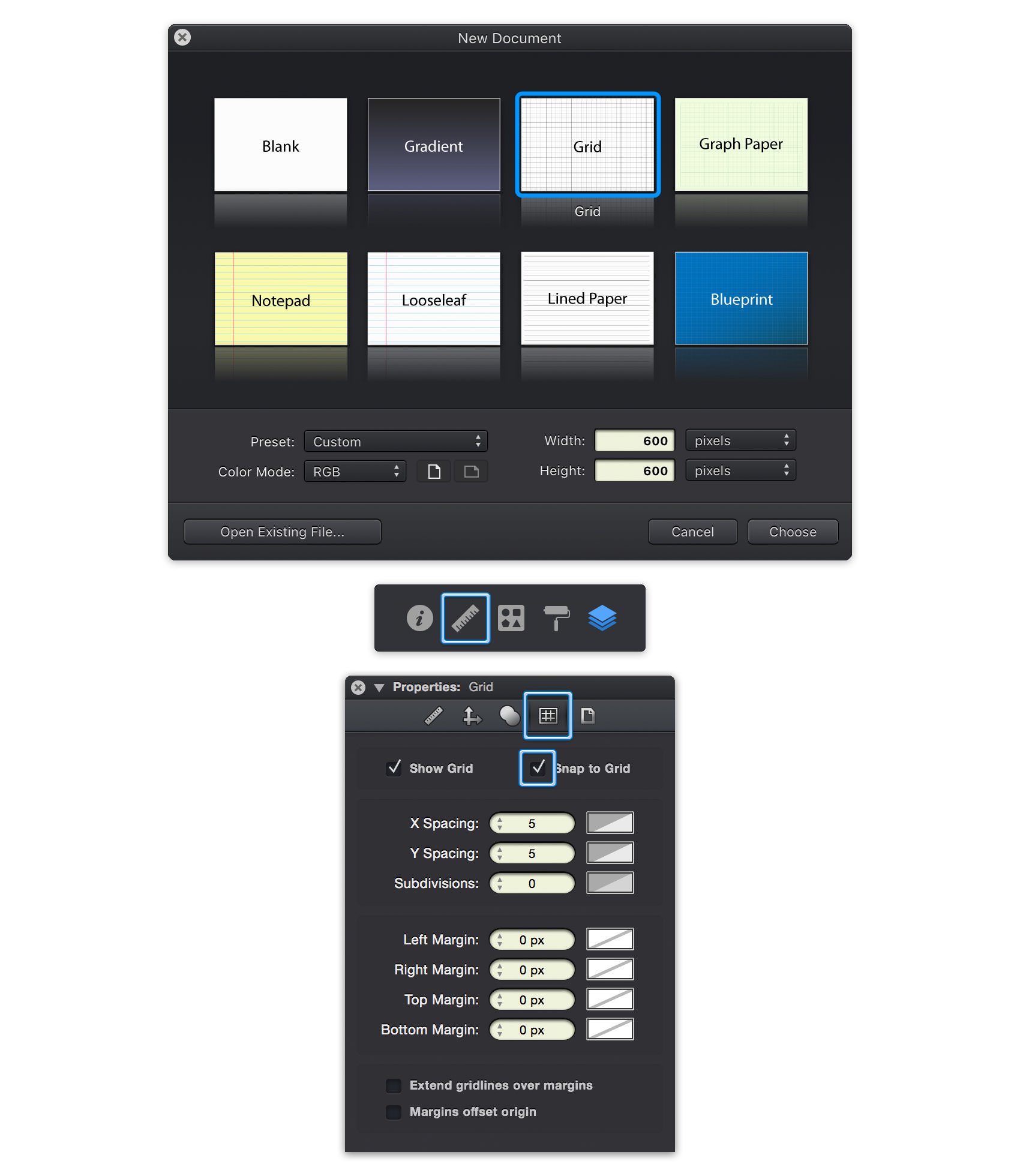
Step 2
Focus on the Toolbar and notice that by default the Fill color is set to white while the Stroke color is set to black. Click the Fill color well and set it to R=0 G=152 B=245 and then click the Stroke color well. Drag the Alpha slider to 0% and this will make your Stroke invisible.
Pick the Ellipse Tool (O), move to your canvas and create a 190 px circle - the grid and the Snap to Grid feature will ease your work. Hold the Shift key while dragging to create a perfect circle.

Step 3
Make sure that your circle is still selected and go to the Alignment pane from the Properties panel. Simply click the Horizontal Centers and Vertical Centers buttons to move your selected shape in the center of the canvas.
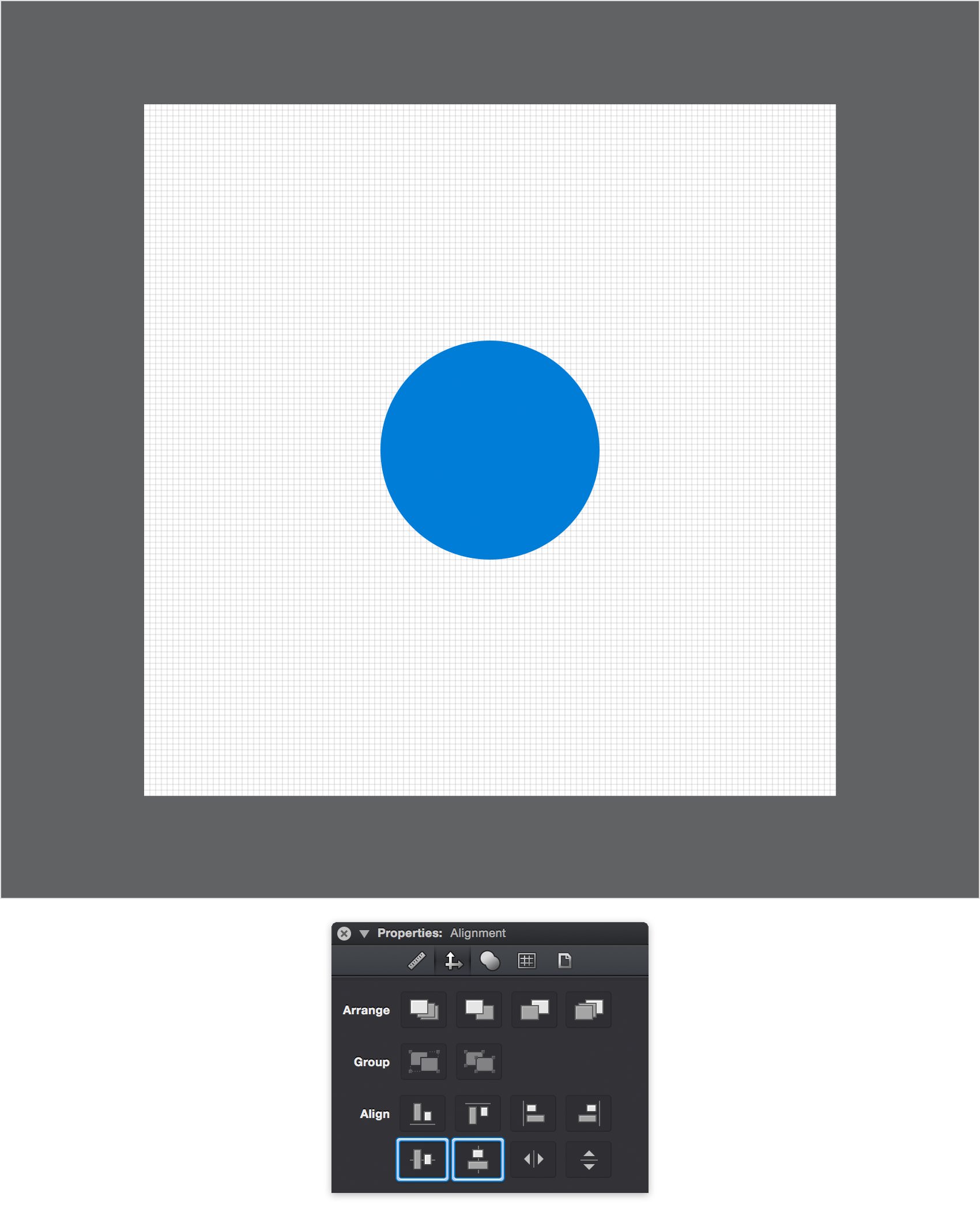
Step 4
Return to your Toolbar and replace the existing Fill color with R=0 G=90 B=150. Pick the Ellipse Tool (L), create a 180 px circle and center it using the same Horizontal Centers and Vertical Centers buttons from the Alignment pane.
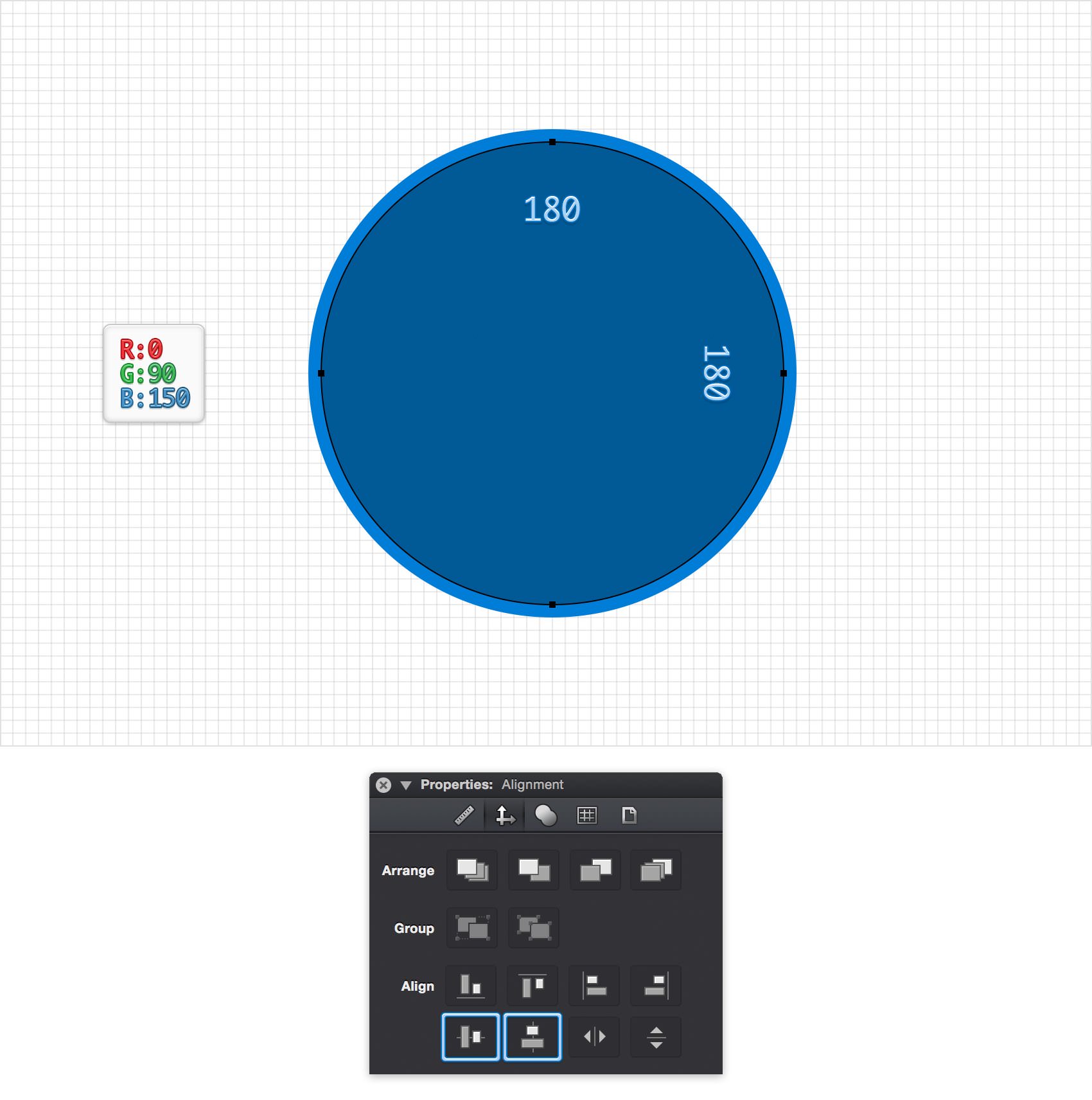
Step 5
Get back to your Toolbar and replace the existing Fill color with R=255 G=251 B=229. Make sure that the Ellipse Tool (L) is still active, create a 170 px circle and center it.
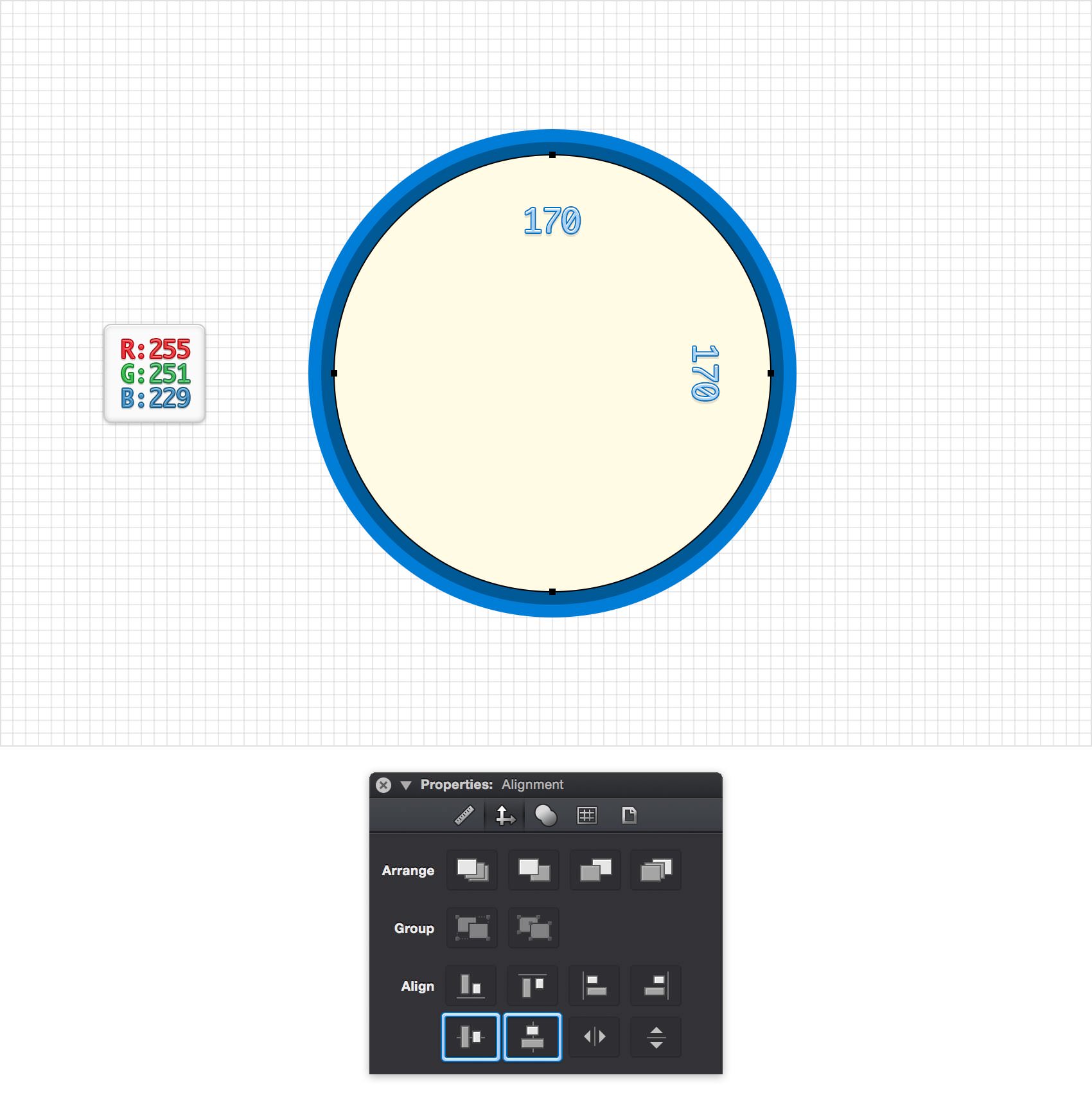
Step 6
Return to your Toolbar and replace the existing Fill color with R=55 G=54 B=65. Using the Ellipse Tool (L), create a 10 px circle and don't forget to center it.

Step 7
Get back to your Toolbar. This time make sure that the Fill is invisible and then set the Stroke color to R=104 G=104 B=115.
Focus on the top side of your shapes and pick the Pen Tool (P) or the Line Tool (L). Create a 5 px, vertical path and place it exactly as shown in the following image. Once again, the grid and the Snap to Grid feature will come in handy.
Make sure that your little path stays selected and go to the Stroke pane from the Appearance panel. Set the Line Weight to 1 px and check that Round Cap button. If the Appearance panel is not currently visible, you can easily open it using the leftmost icon that lies above the Layers panel.
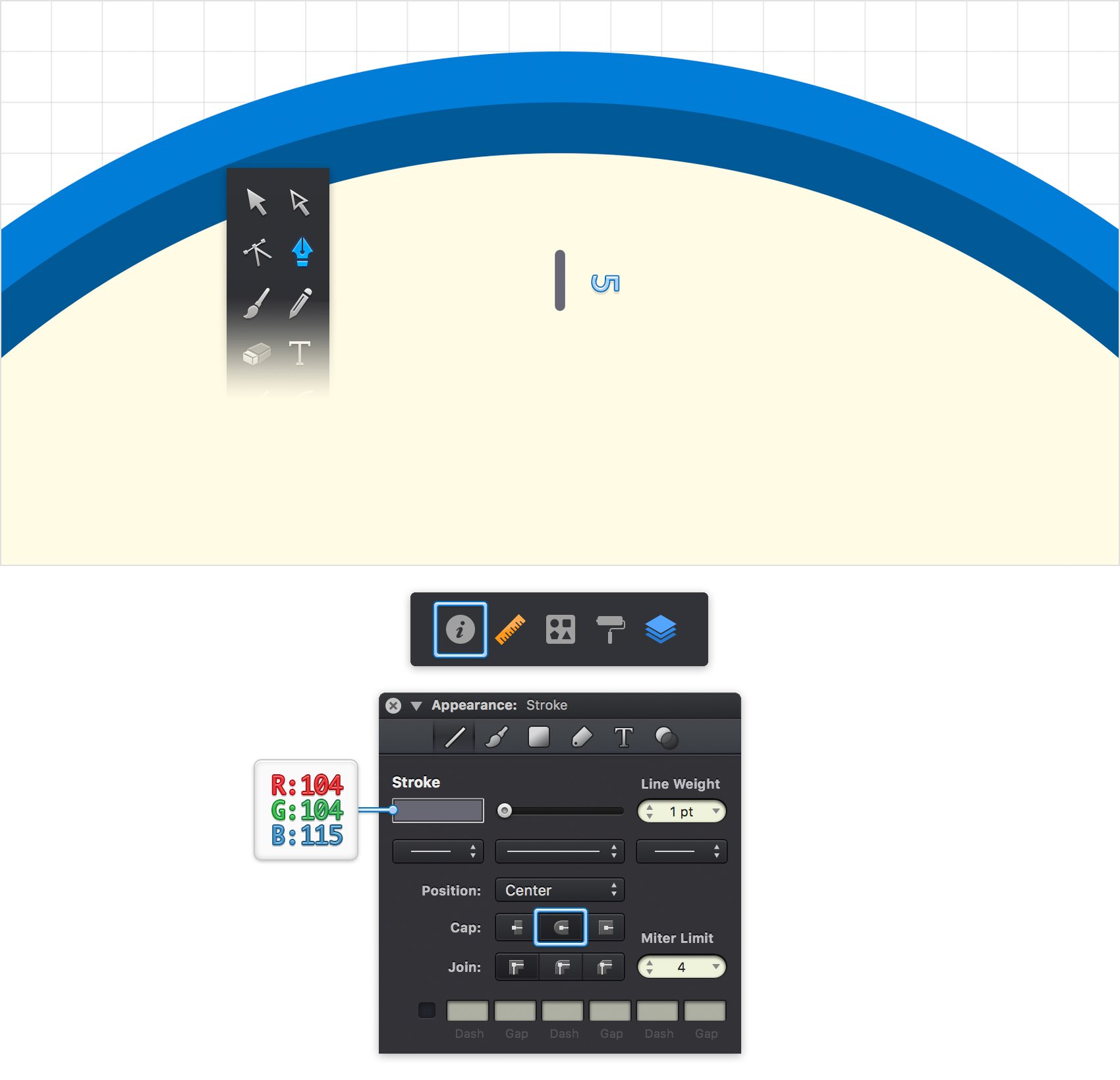
Step 8
Make sure that your vertical path stays selected, pick the Rotate Tool (R) and you will notice a tiny cross icon in the center of the selection. That's the reference point and keep in mind that your selected path will rotate according to that point.
Simply drag that cross in the center of your dark circle (the Snap to Grid will ease your work) and then focus on the tool options bar. Set the Angle to 6 degrees and then click that Copy button a bunch of times (fifty-nine times, to be more specific).
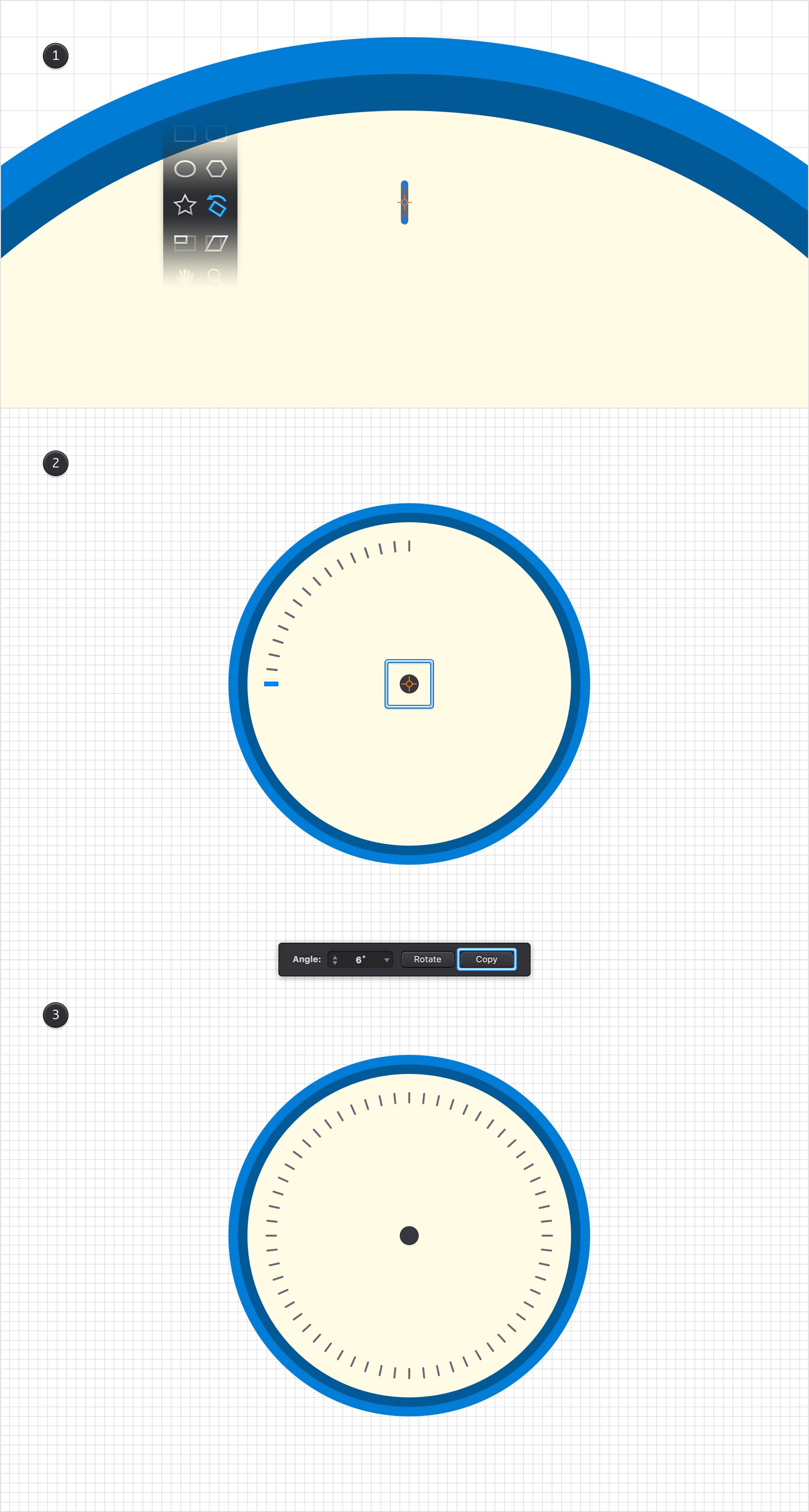
Step 9
Reselect all your tiny paths, focus on the Path Tools pane from the Properties panel and click that Make Compound Path button. This will unite all selected paths into a single compound path that can be selected/edited a lot easier.
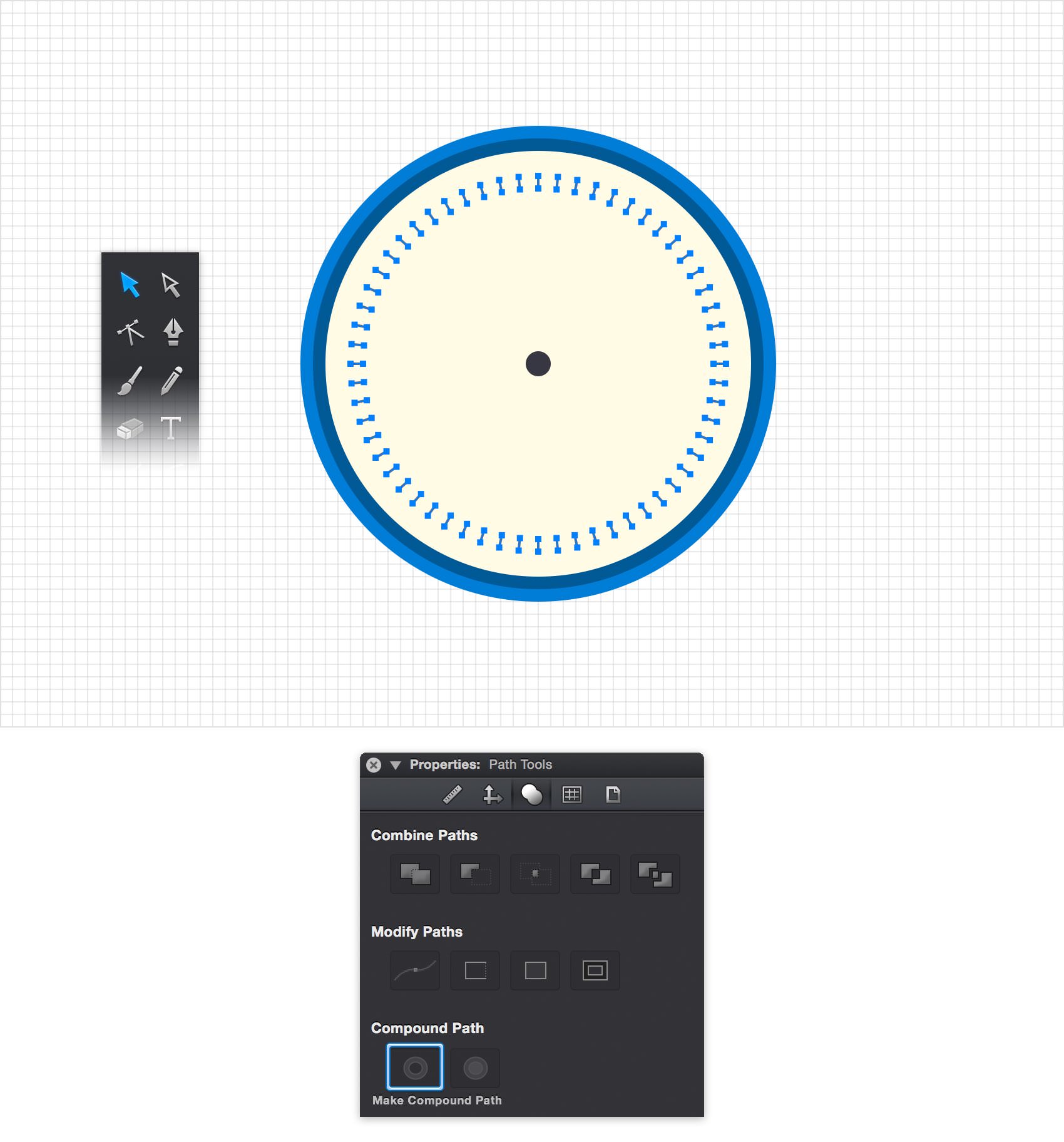
Step 10
Return to your Toolbar and replace the existing Stroke color with R=55 G=54 B=65.
Pick the Pen Tool (P) or the Line Tool (L), create a 10 px, vertical path and place it exactly as shown in the following image. Make sure that it stays selected and focus on the Stroke pane. Set the Line Weight to 2 pt and check the Round Cap button.
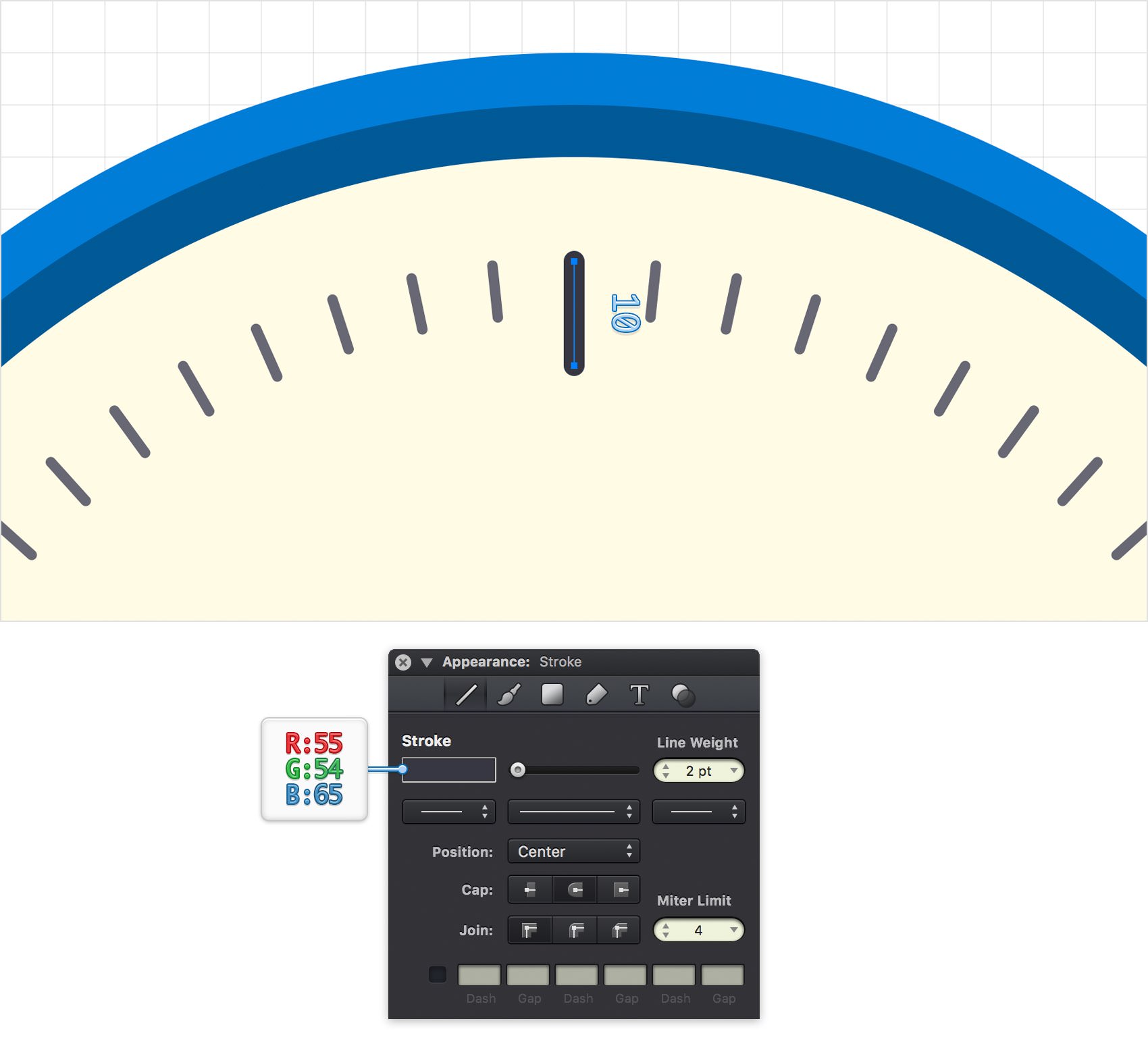
Step 11
Make sure that your 10 px, vertical path stays selected and pick the Rotate Tool (R). Simply drag that reference point in the center of your dark circle then focus on the Tool Options bar. Set the Angle to 30 degrees then click that Copy button eleven times. Select all twelve paths and turn them into a new compound path using that same Make Compound Path button from the Path Tools pane.
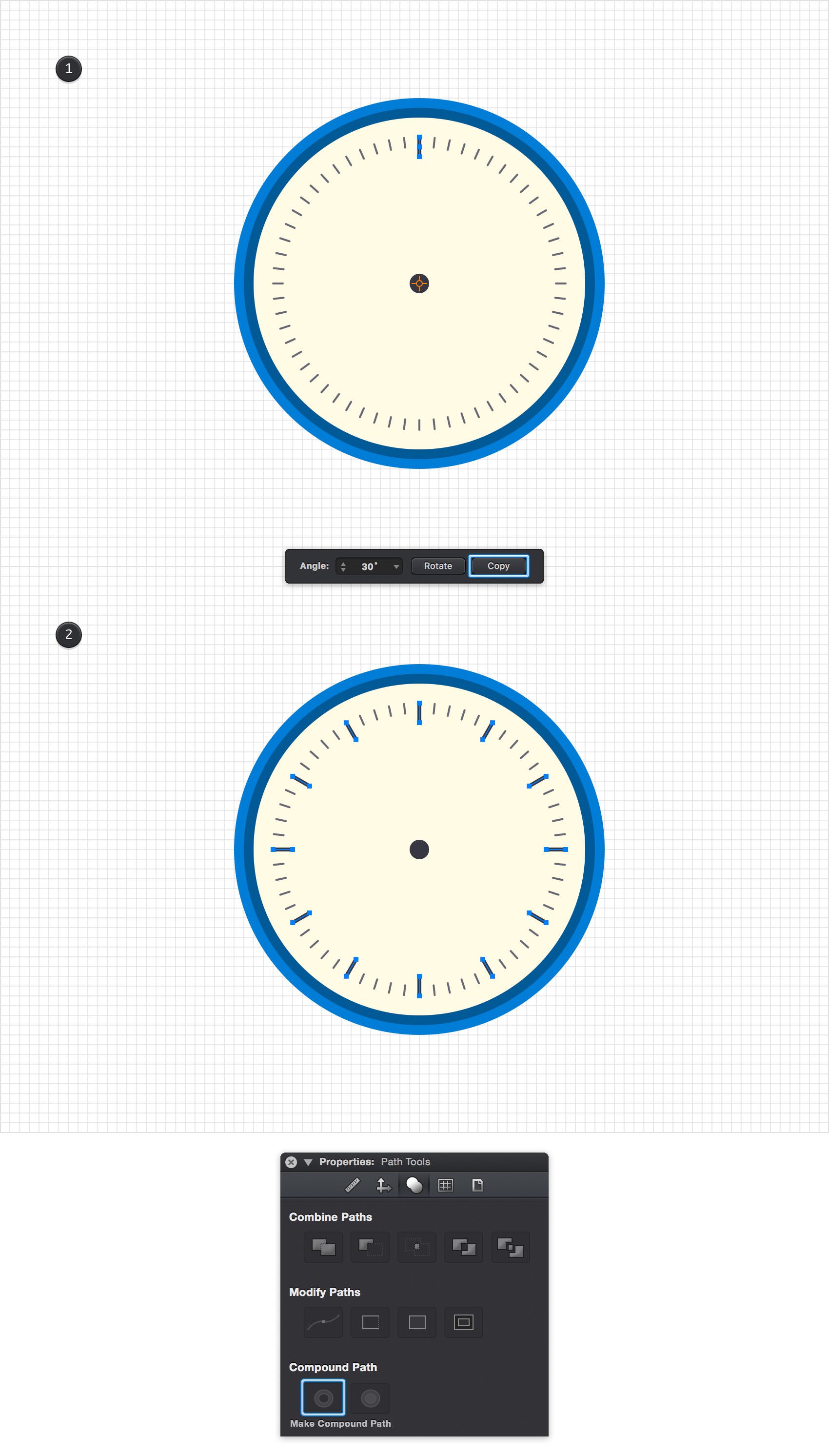
Step 12
Get back to your Toolbar and replace the existing Stroke color with R=7 G=114 B=179.
Pick the Pen Tool (P), create a 65 px, vertical path and place it as shown in the first image. Make sure that this new path stays selected and focus on the Stroke pane. Set the Line Weight to 2 px and check the Round Cap button.
Switch to the Rotate Tool (R), drag the reference point in the the center of your dark circle and then rotate your blue path as shown in the third image.
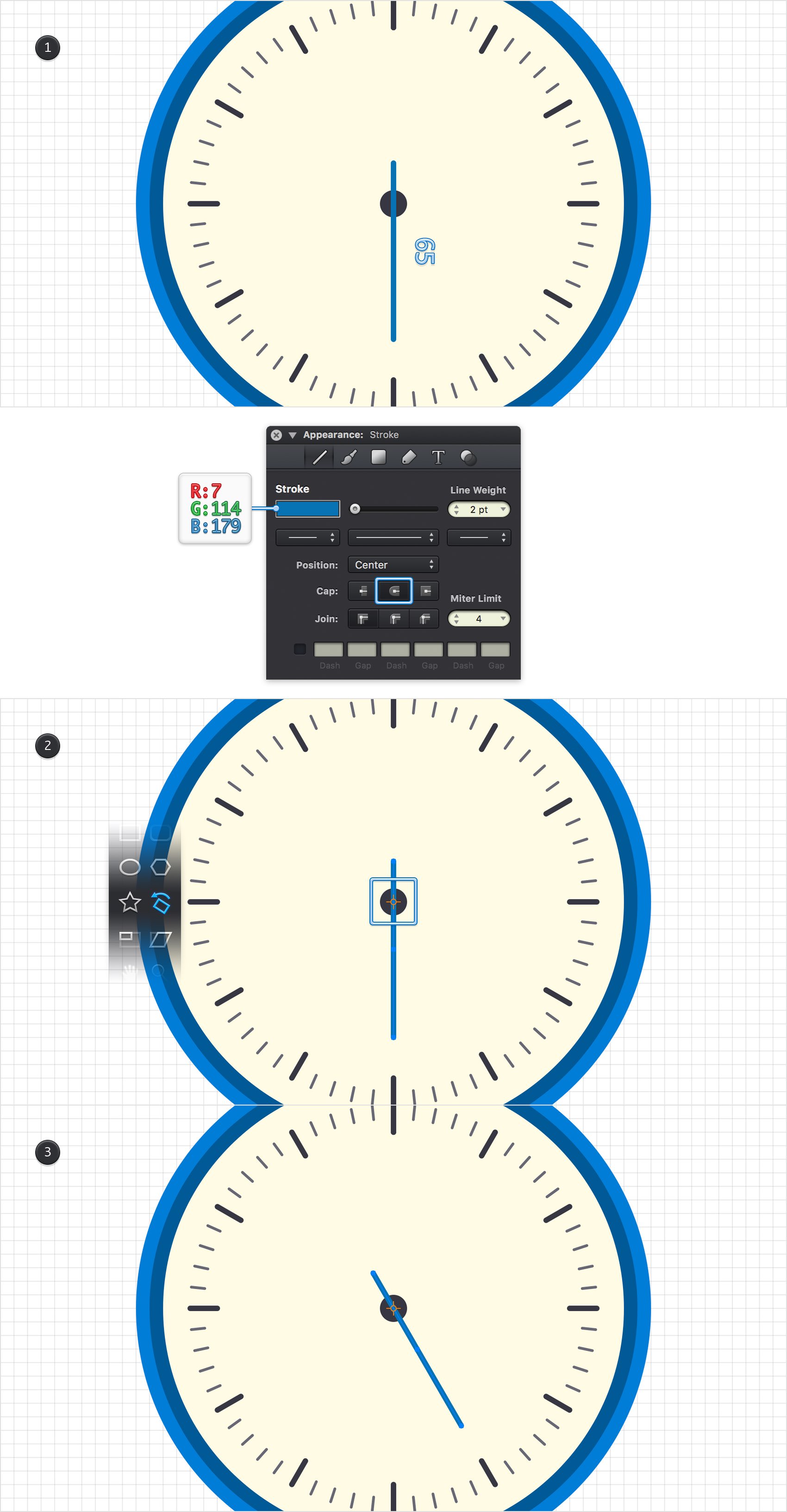
Step 13
Pick the Pen Tool (P), create an 80 px, horizontal path and place it as shown in the first image. Make sure that this new, blue path stays selected and focus the Stroke pane. Set the Line Weight to 2 pt and check that Round Cap button. Switch to the Rotate Tool (R), drag the reference point in the the center of your dark circle and then rotate your path as shown in the second image.
Get back to your Toolbar and replace the existing Stroke color with R=219 G=65 B=0.
Make sure that the Pen Tool (P) is still active, create a 90 px, horizontal path and place it as shown in the third image. Make sure that this new path stays selected and return to the Stroke pane. Set the Line Weight to 2 pt and don't forget to check that Round Cap button. Finally, switch to the Rotate Tool (R) and rotate this orange path as shown in the fourth image.

Step 14
Select your largest circle, focus on the Effects pane from the Appearance panel and check the box that stands for the existing Drop Shadow to activate it.
Enter -1 in the Y box and 0 in the other two boxes and then click the color well that stands for this effect. Drag the Alpha slider to 5% and make sure that the color is set to black ( R=0 G=0 B=0).

Step 15
Make sure that your largest circle stays selected and keep focusing on the Effects pane. Right click on the existing Drop Shadow effect and go to Duplicate. Select the newly added effect and replace the existing attributes with the ones shown in the following image.

Step 16
Make sure that your largest circle stays selected, keep focusing on the Effects pane and duplicate the bottom Drop Shadow. Select the newly added effect and replace the existing attributes with the ones shown in the following image.
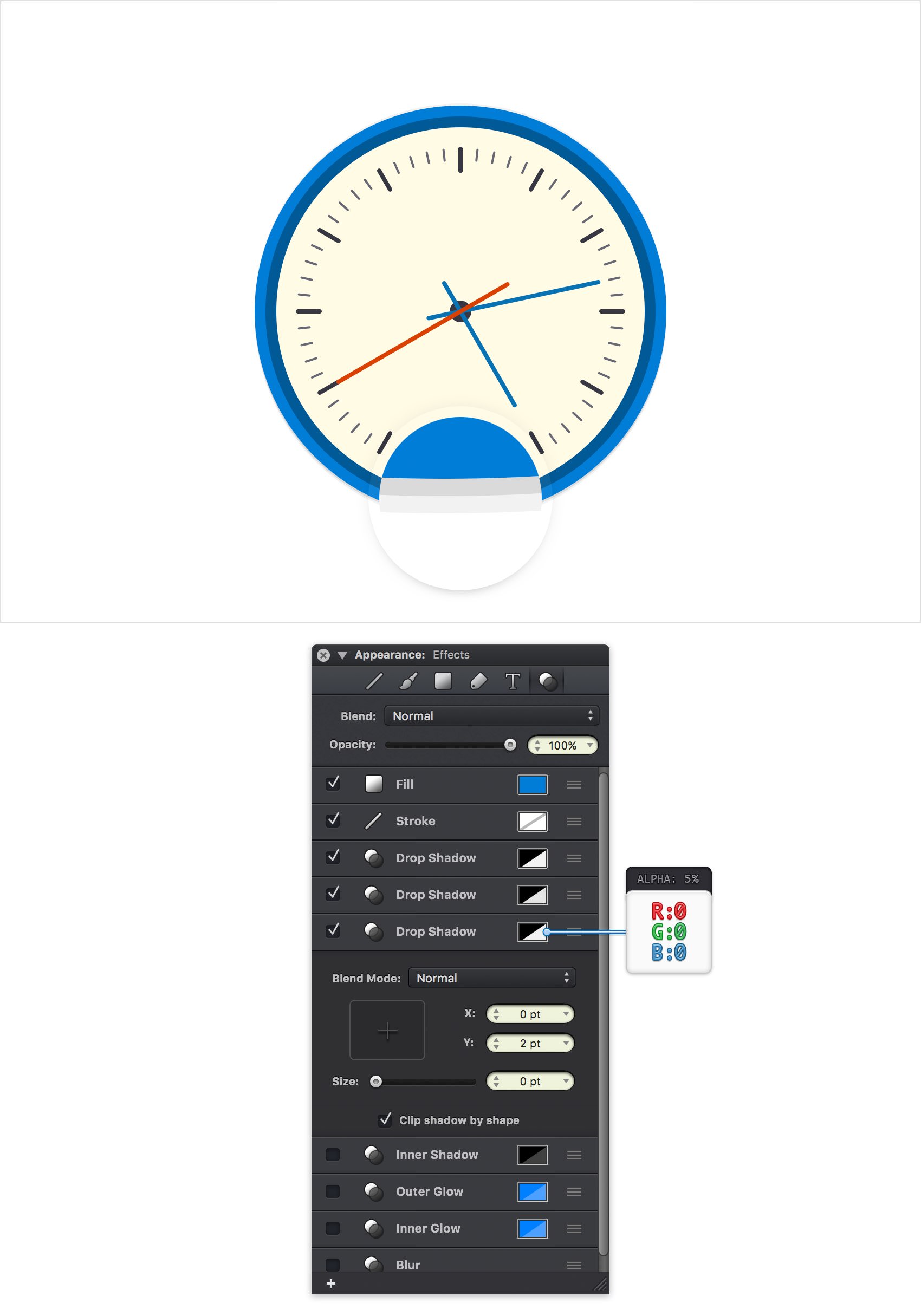
Step 17
Make sure that your largest circle stays selected, keep focusing on the Effects pane and duplicate the bottom Drop Shadow. Select the newly added effect and replace the existing attributes with the ones shown in the following image.
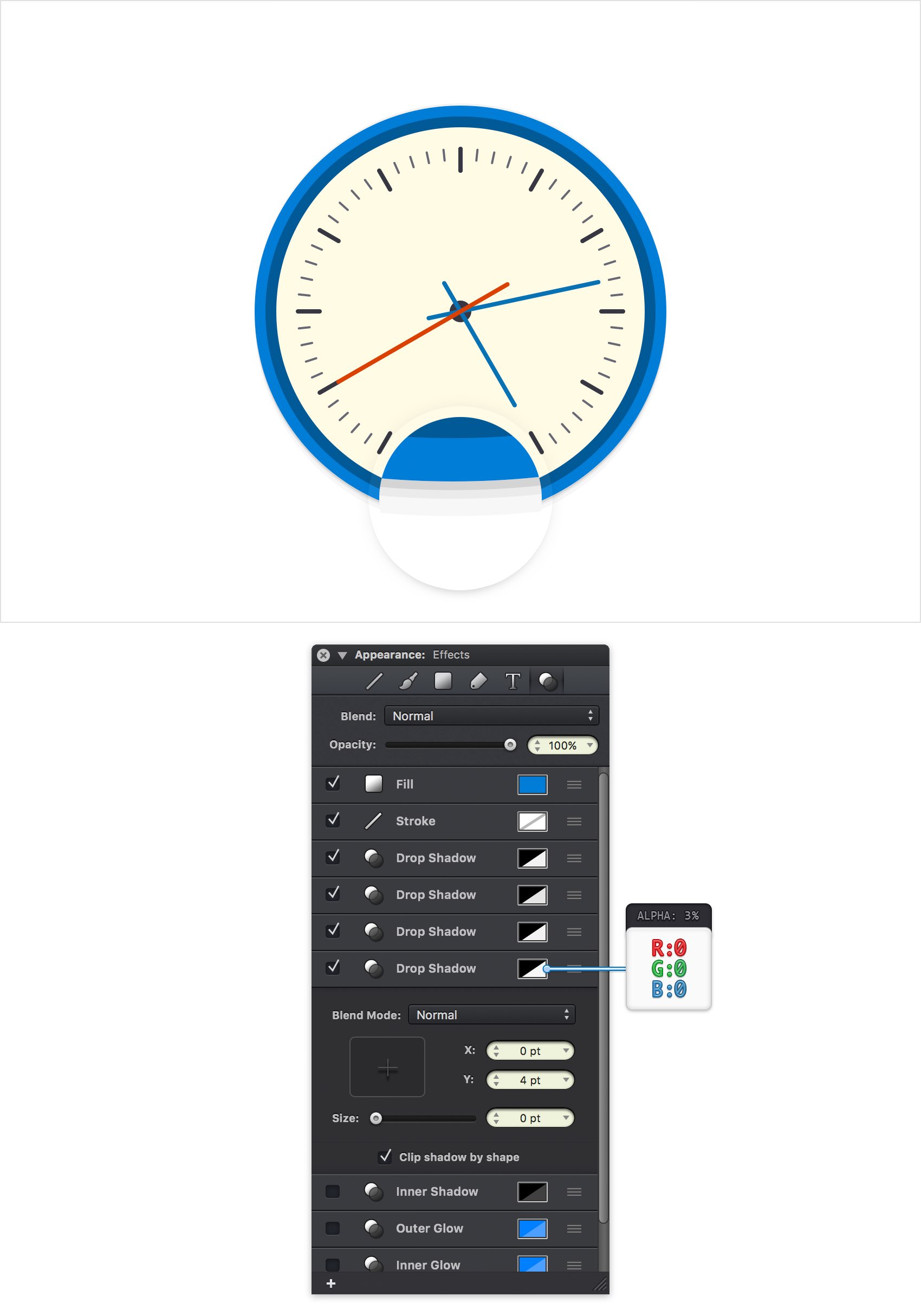
Step 18
Make sure that your largest circle stays selected, keep focusing on the Effects pane and duplicate the bottom Drop Shadow. Select the newly added effect and replace the existing attributes with the ones shown in the following image.
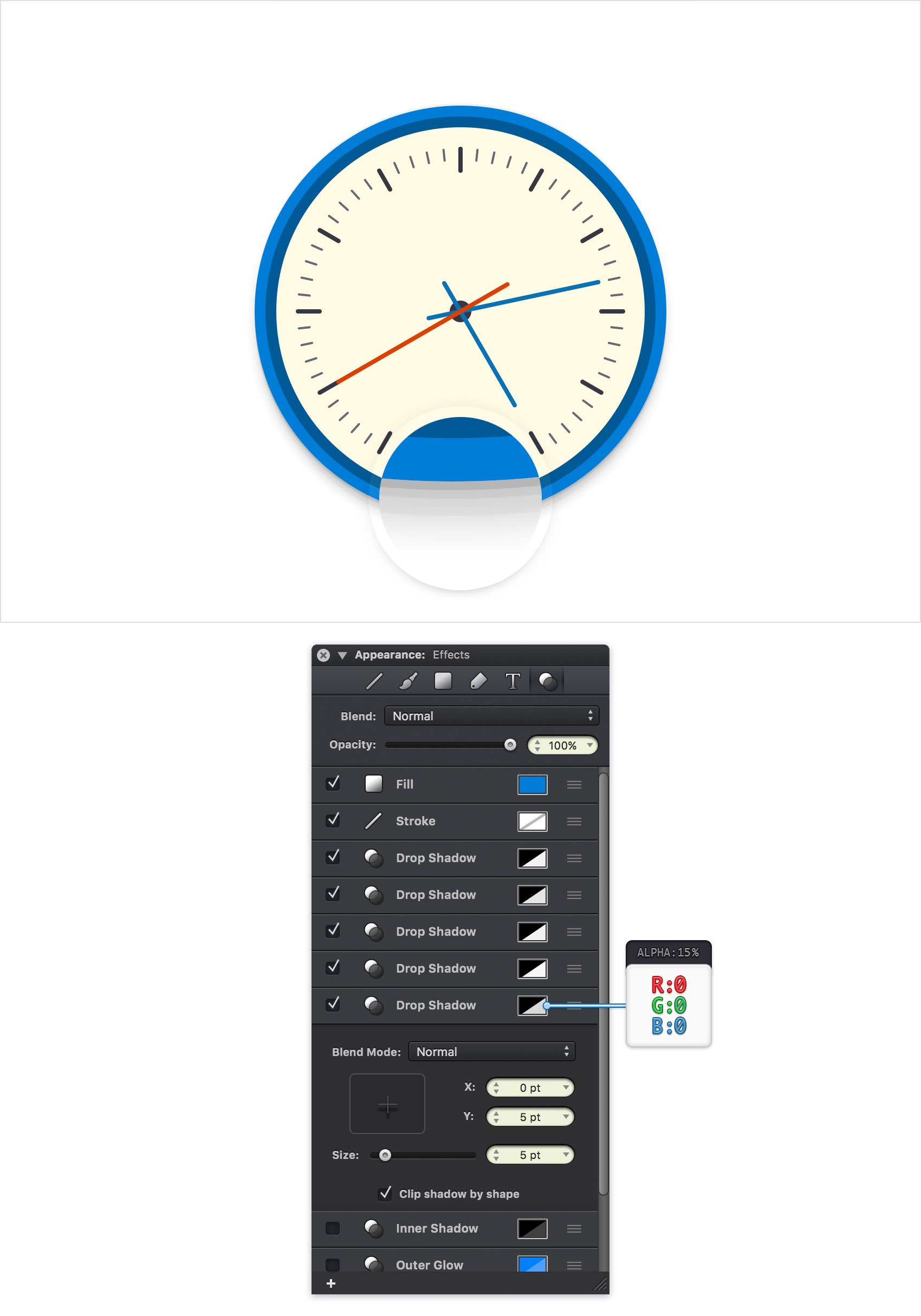
Step 19
Make sure that your largest circle stays selected, keep focusing on the Effects **pane and and activate the existing Inner Shadow**.
Select this new effect and change its Blend Mode to Soft Light. Enter 0 pt in the X box and 3 pt in the Y box and then drag that Size slider to 5 pt. Click the color well that stands for this effect, replace the existing color with white and make sure that the Alpha slider is set to 100%.
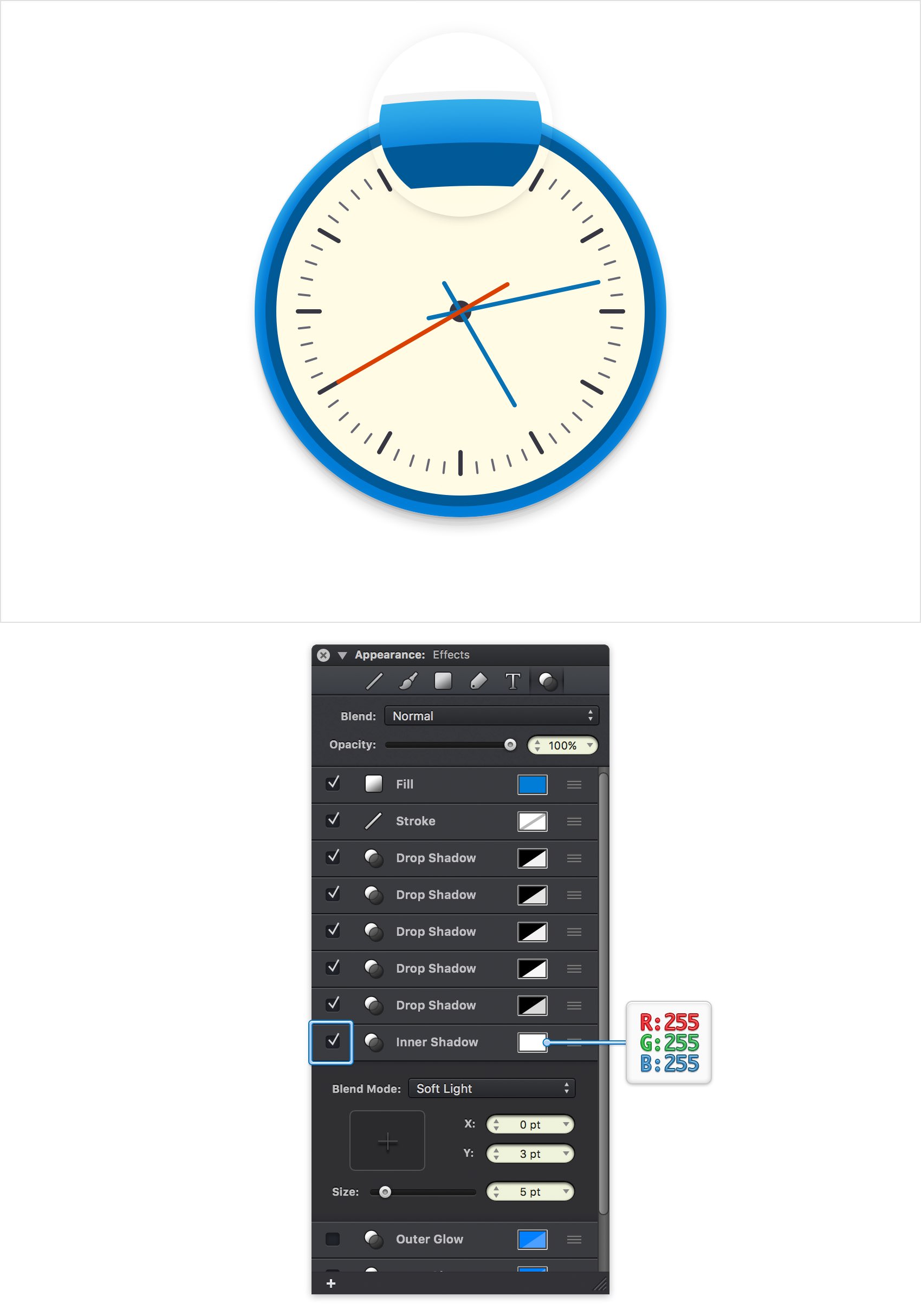
Step 20
Make sure that your largest circle stays selected, keep focusing on the Effects pane and duplicate that Inner Shadow. Select the newly added effect and replace the existing attributes with the ones shown in the following image.
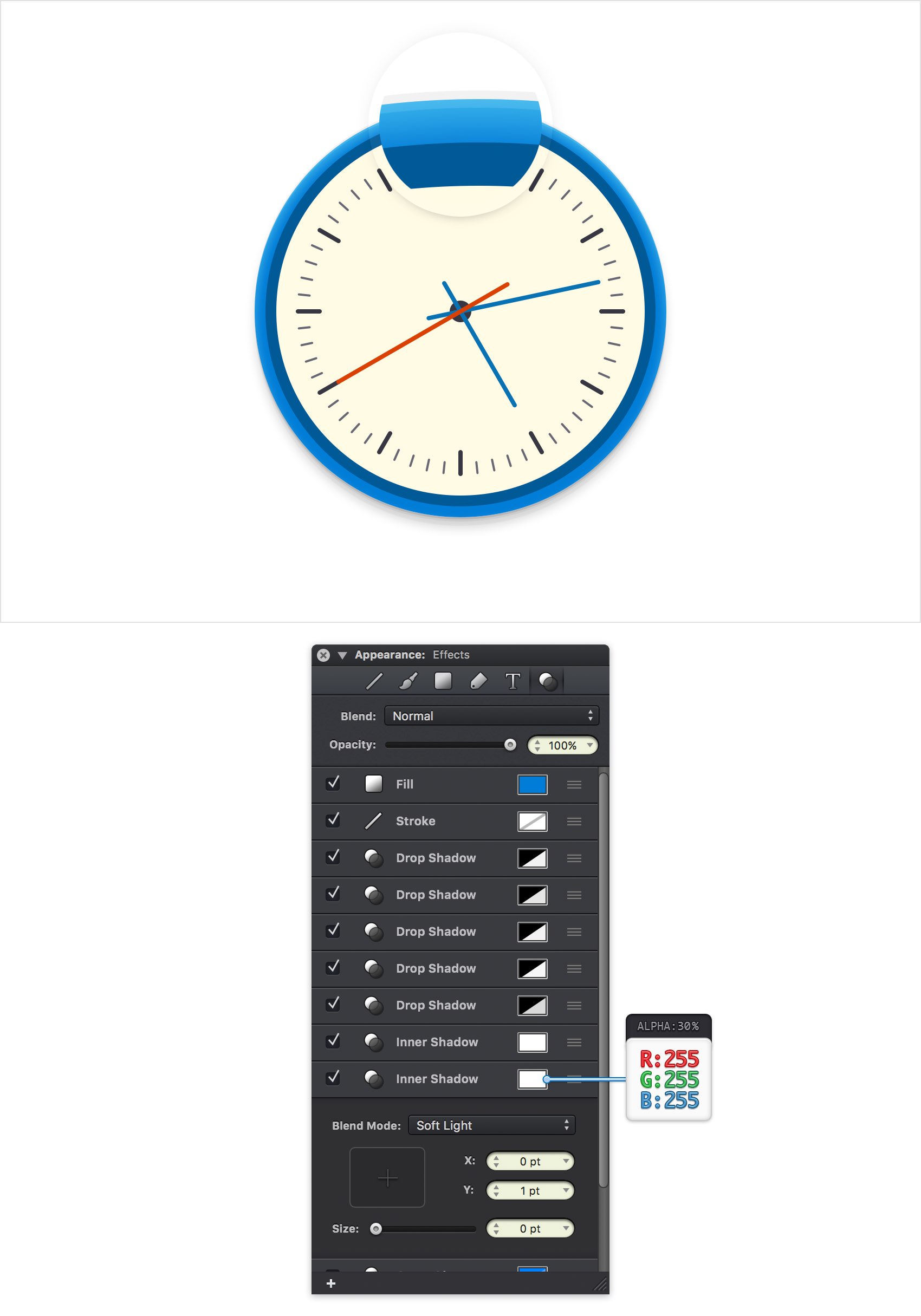
Step 21
Make sure that your largest circle stays selected and keep focusing on the Effects pane. You must add a new Inner Shadow, but first you need to remove one of those inactive effects because you've reached the limit of twelve effects, strokes and fills for one shape.
Simply right click on that inactive Inner Glow effect and go to Remove. Using that plus button from the bottom, left corner of the pane, add a third Inner Shadow for your shape. Make sure that it lies below the other active effects and then enter the attributes shown in the following image.
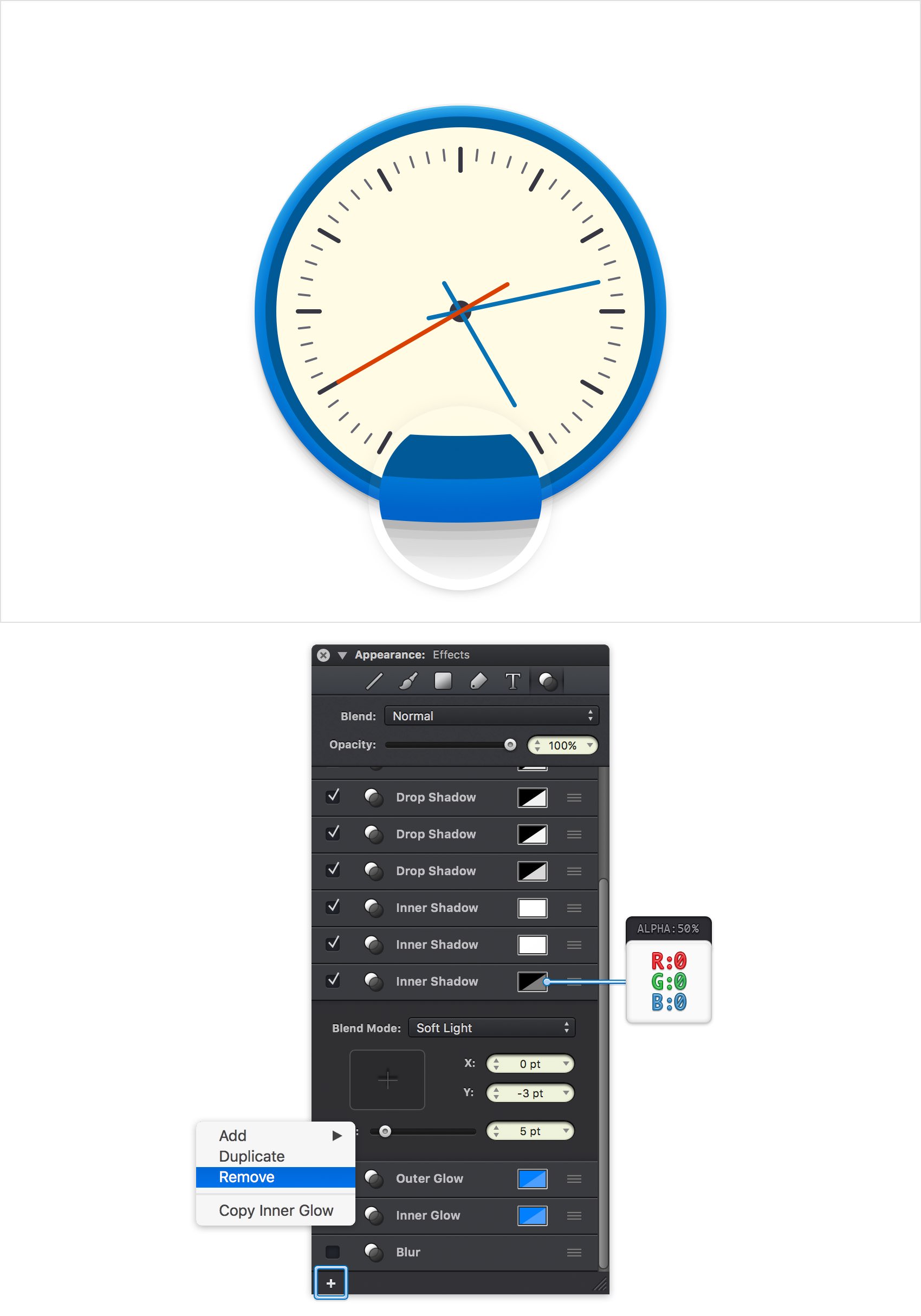
Step 22
Make sure that your largest circle stays selected and keep focusing on the Effects pane. Get rid of that inactive Blur effect and then add a fourth Inner Shadow for your shape. Make sure that it lies below the other active effects and then enter the attributes shown in the following image.
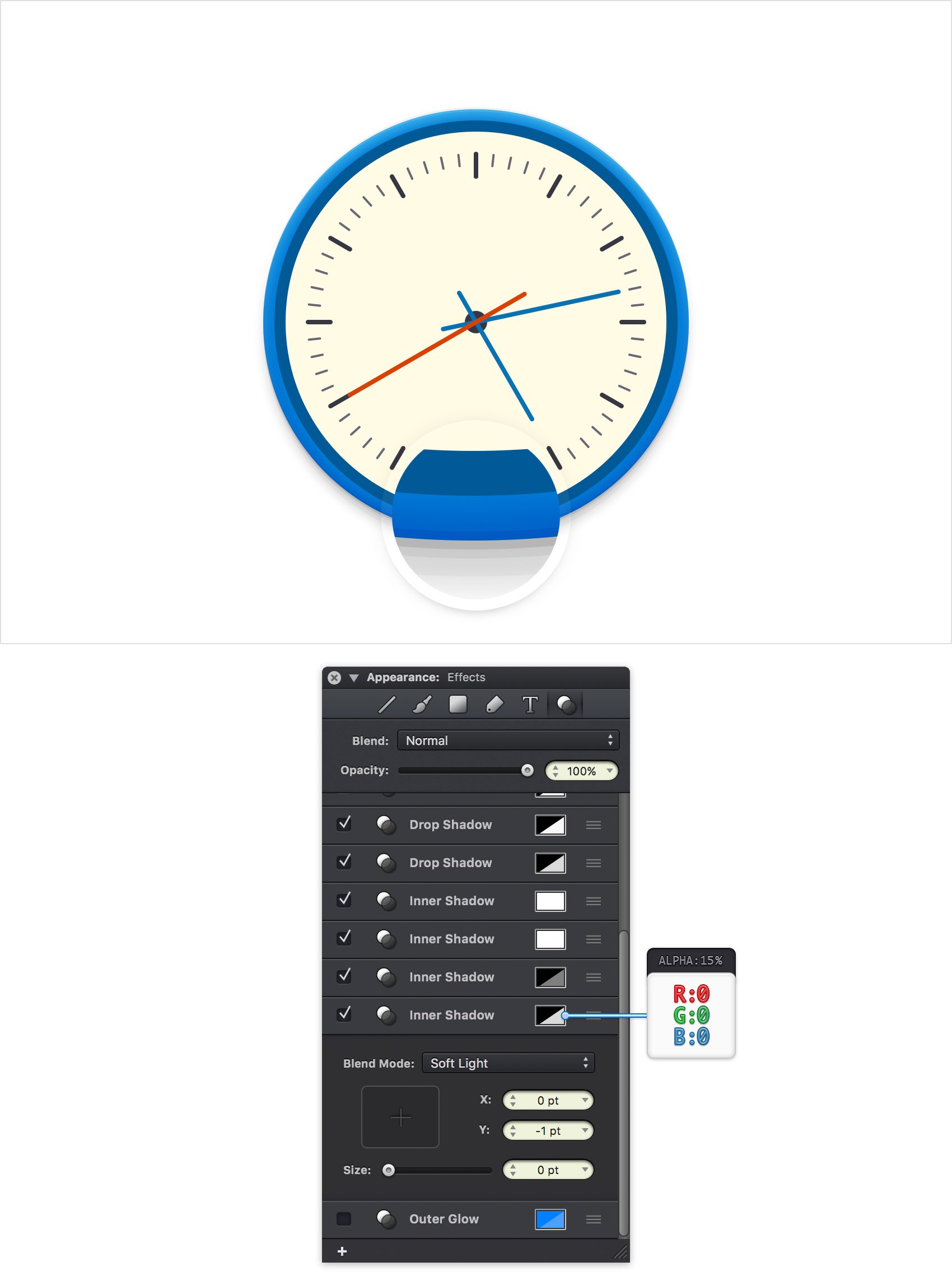
Step 23
Make sure that your largest circle stays selected and keep focusing on the Effects pane. Activate that Outer Glow effect and enter the attributes shown in the following image.
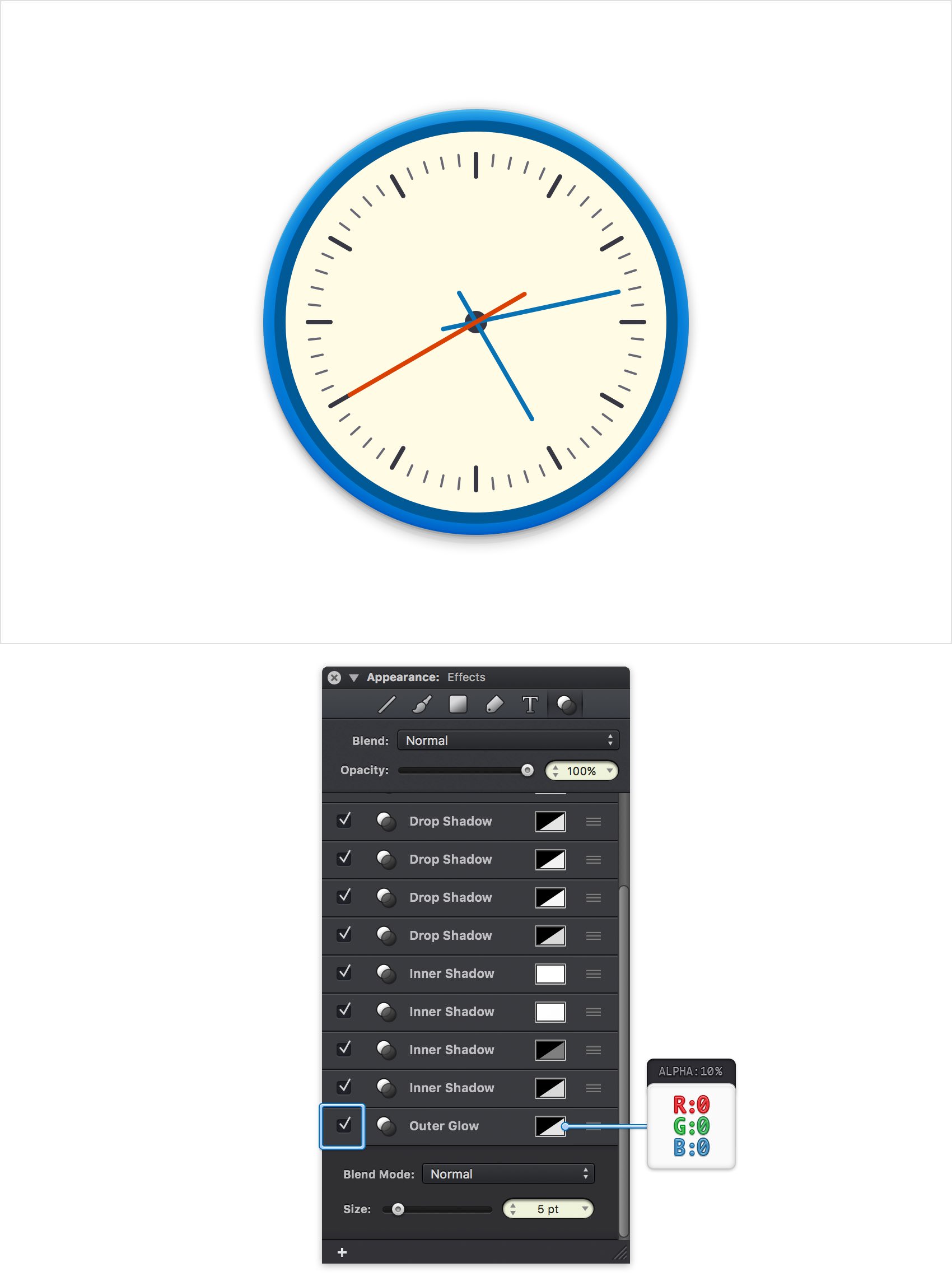
Step 24
Move to the smaller, blue circle, select it and return to the Effects pane. Activate the existing Drop Shadow and enter the attributes shown in the following image.
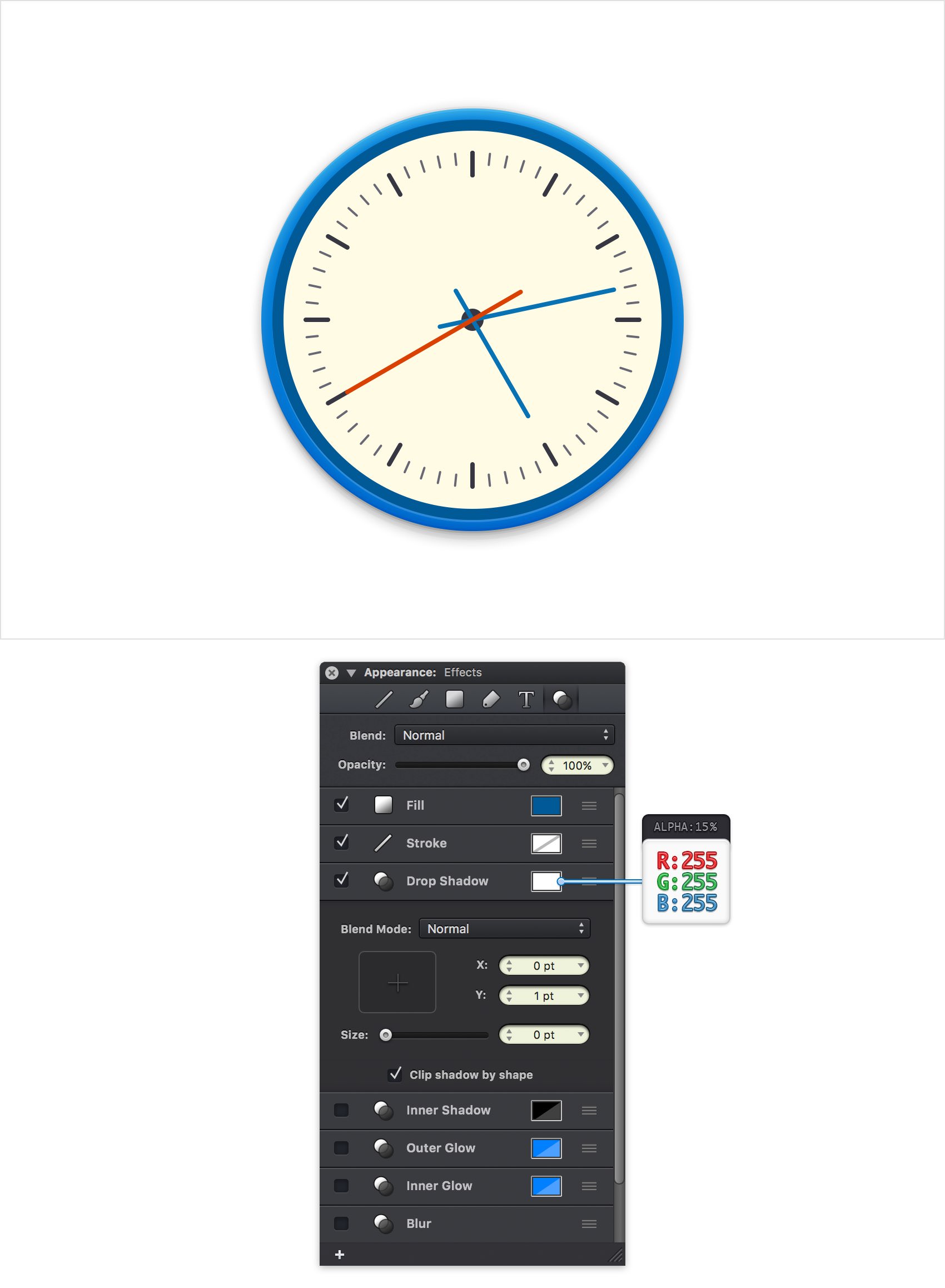
Step 25
Make sure that your smaller, blue circle stays selected and keep focusing on the Effects pane. Activate the existing Inner Shadow and enter the attributes shown in the following image.

Step 26
Make sure that your smaller, blue circle stays selected, keep focusing on the Effects pane and duplicate the existing Inner Shadow. Focus on the this new effect and enter the attributes shown in the following image.

Step 27
Make sure that your smaller, blue circle stays selected and keep focusing on the Effects pane. Activate the existing Outer Glow and enter the attributes shown in the following image.
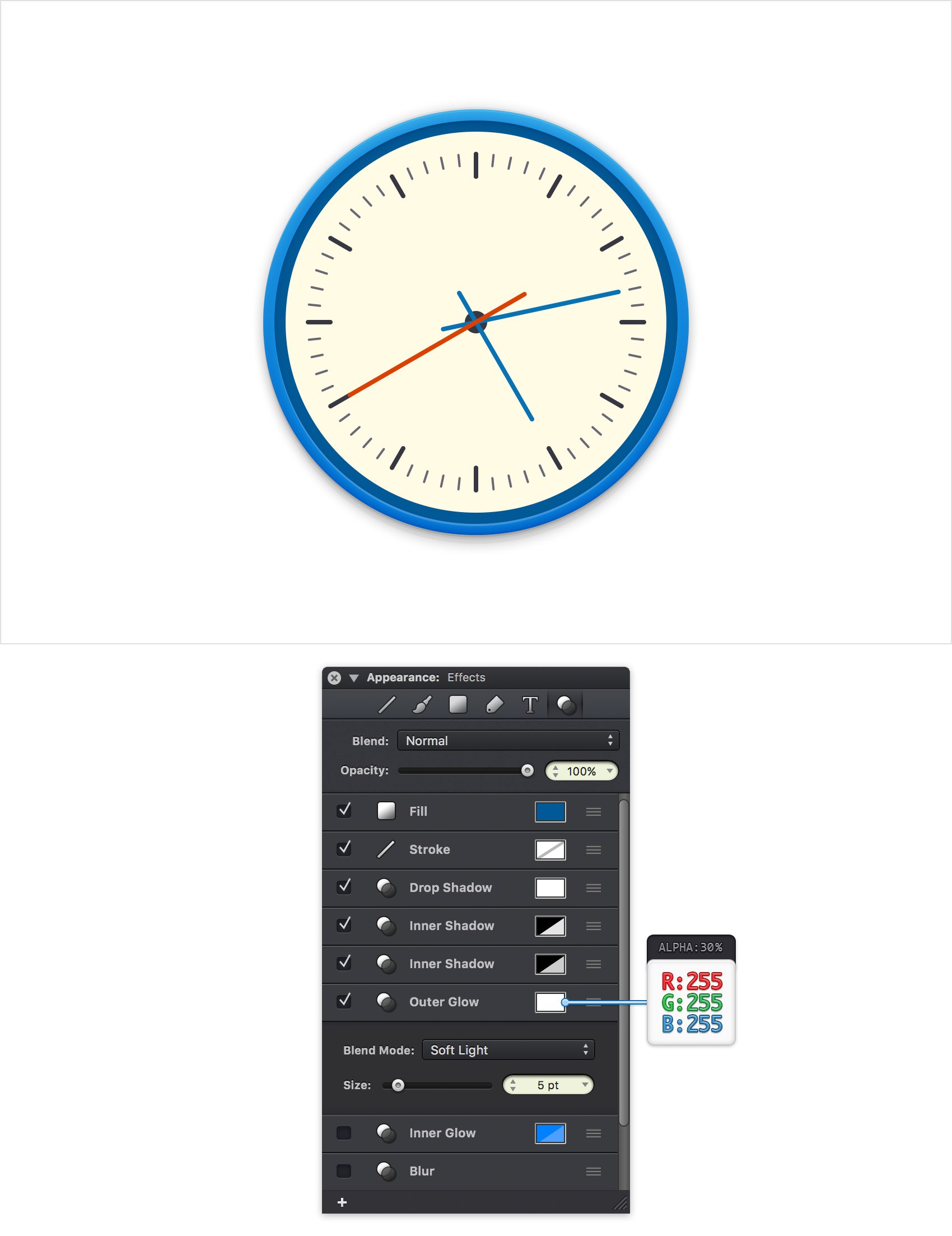
Step 28
Make sure that your smaller, blue circle stays selected and keep focusing on the Effects pane. Activate the existing Inner Glow and enter the attributes shown in the following image.
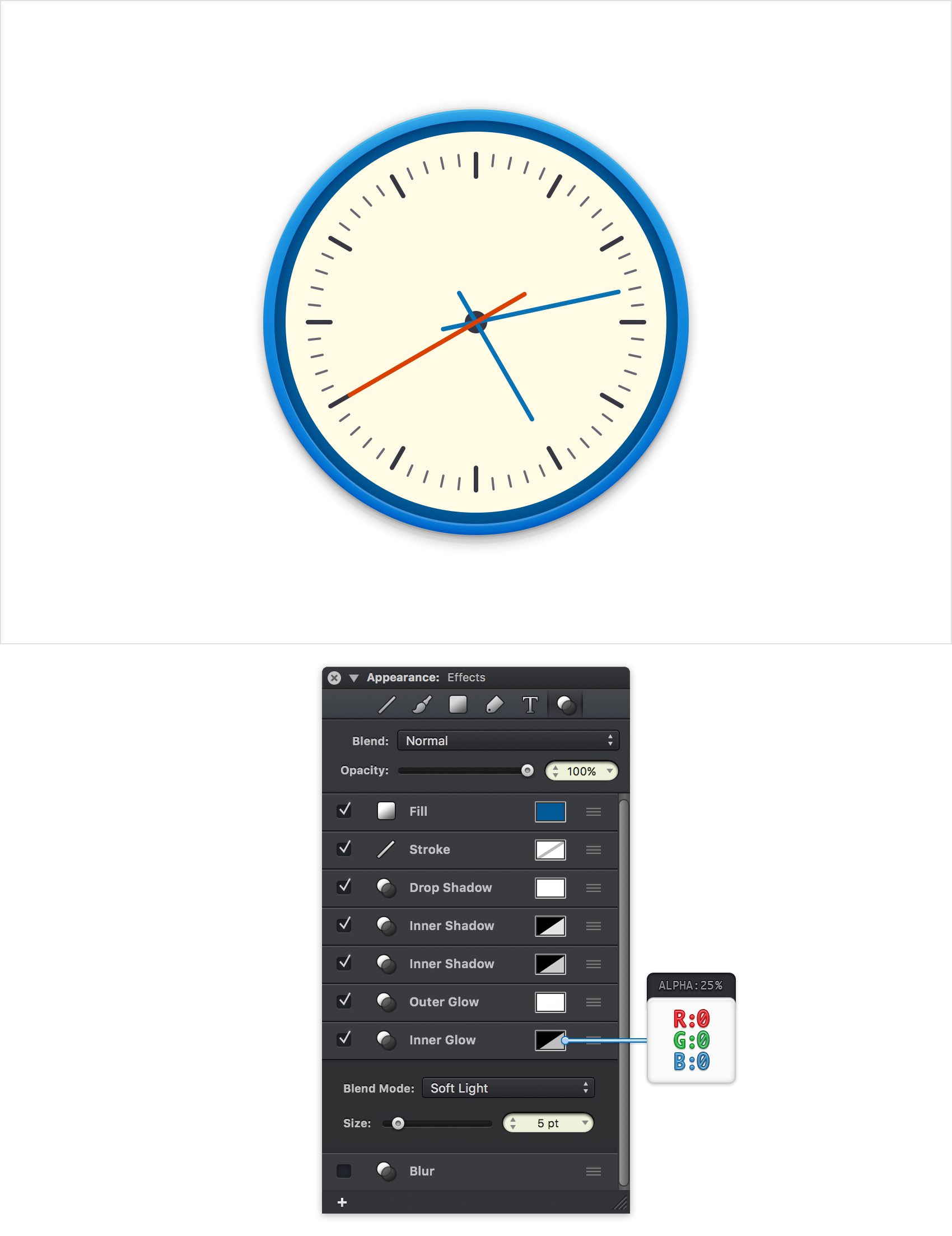
Step 29
Move to your pale yellow circle and make sure that it stays selected. Focus on the Effects pane and select the existing Stroke. Drag the Width slider to 1 pt, select Inside from the Position drop-down menu and then click that color well. Make sure that the color is set to black and drag the Alpha slider to 5%.
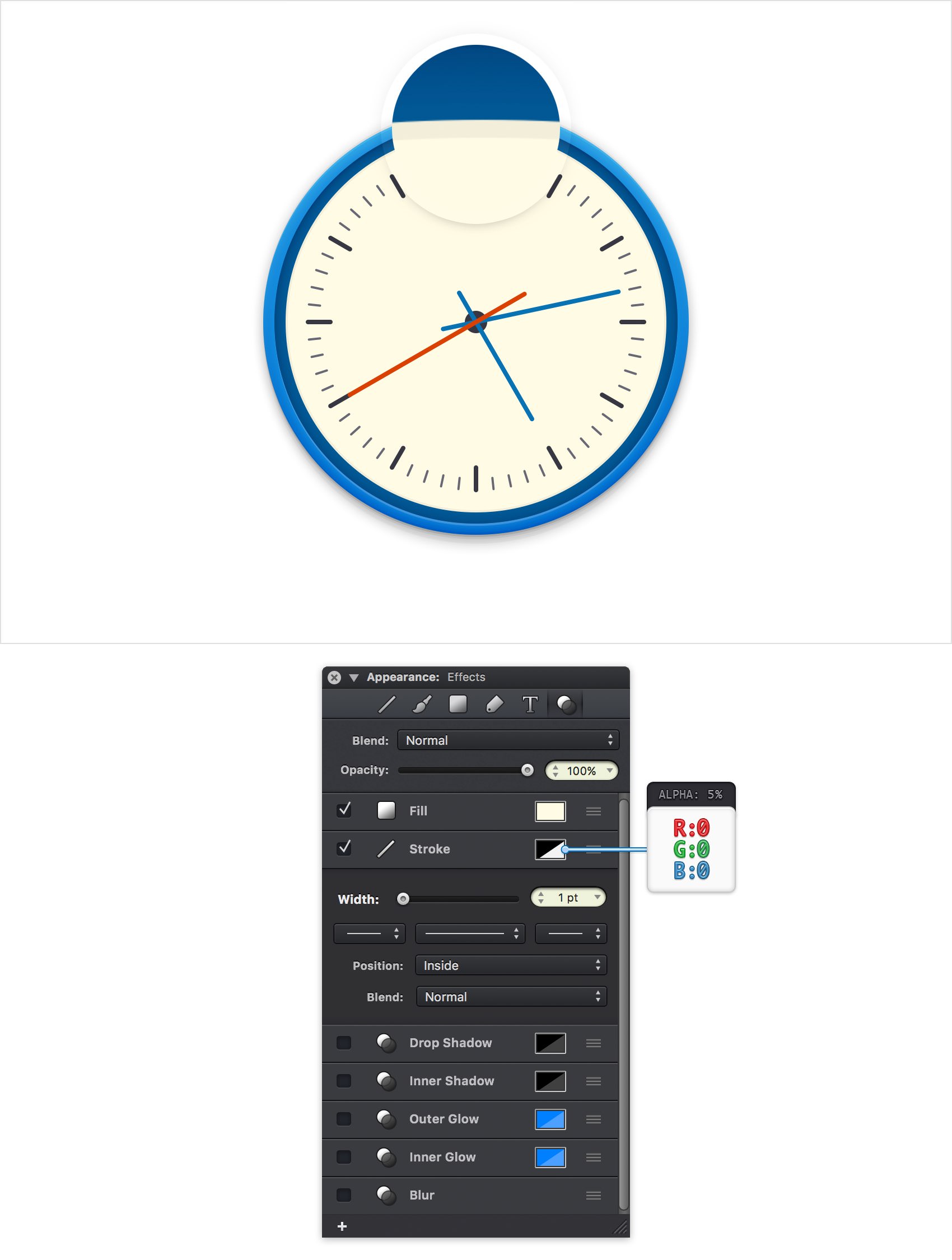
Step 30
Make sure that your pale yellow circle stays selected, keep focusing on the Effects pane and duplicate the Stroke. Focus on this new Stroke and enter the attributes shown in the following image.

Step 31
Make sure that your pale yellow circle stays selected, keep focusing on the Effects pane and duplicate the bottom Stroke. Select this new Stroke and enter the attributes shown in the following image.
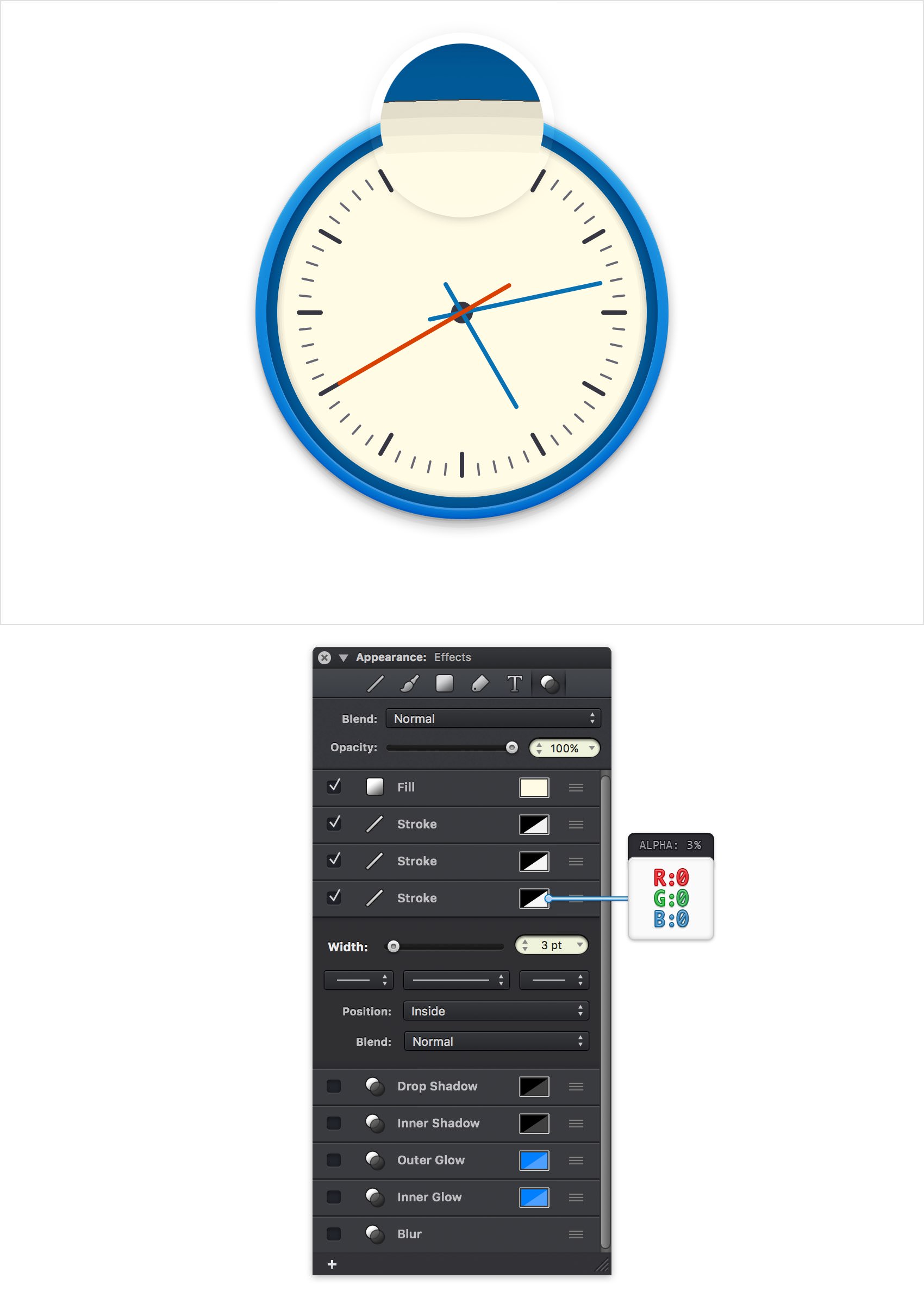
Step 32
Make sure that your pale yellow circle stays selected and keep focusing on the Effects **pane. Activate the existing Inner Glow** effect and enter the attributes shown in the following image.
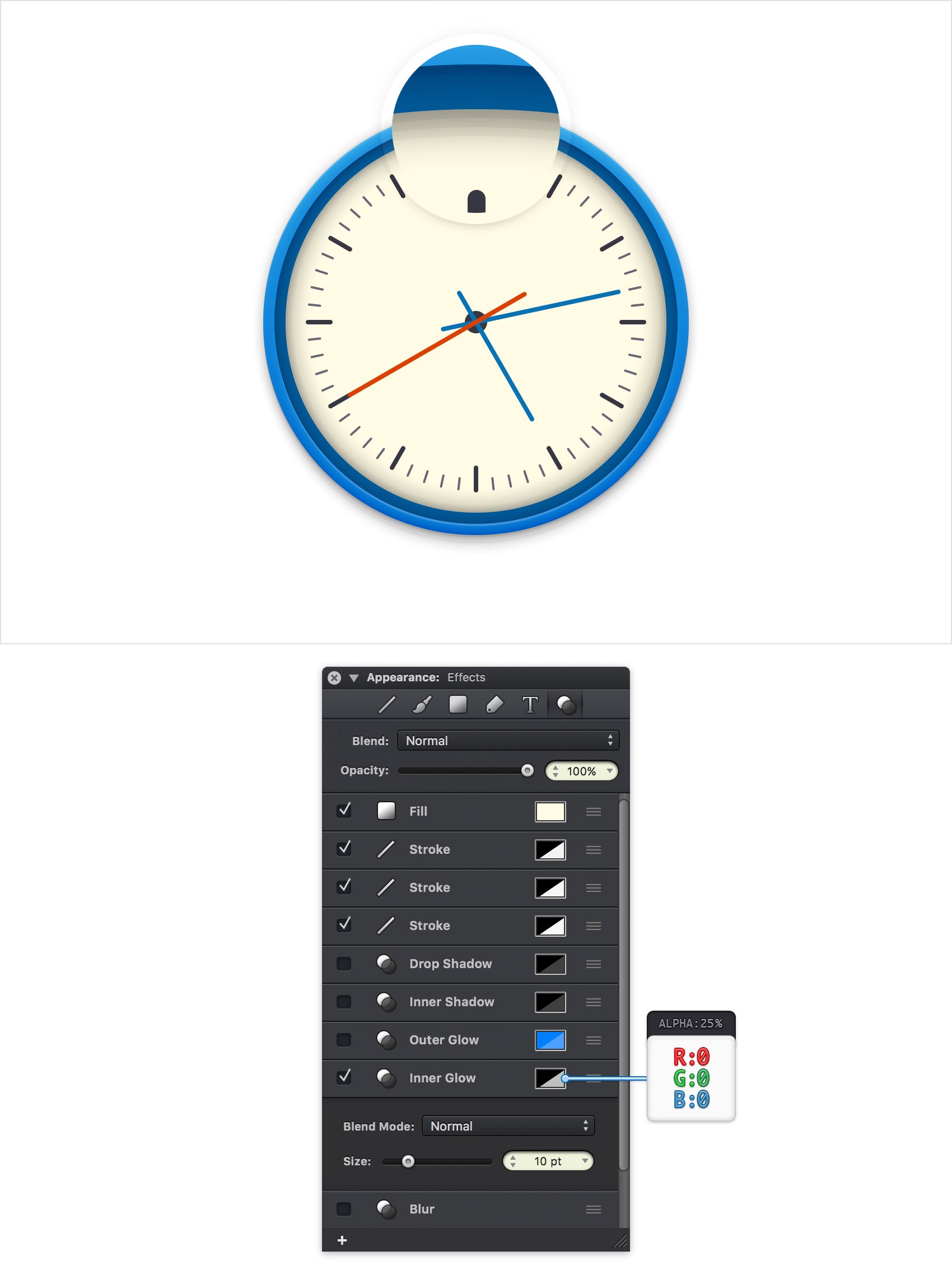
Step 33
Select the blue path that makes up the hours hand and focus on the Effects pane. Activate the existing Drop Shadow and enter the attributes shown in the following image.
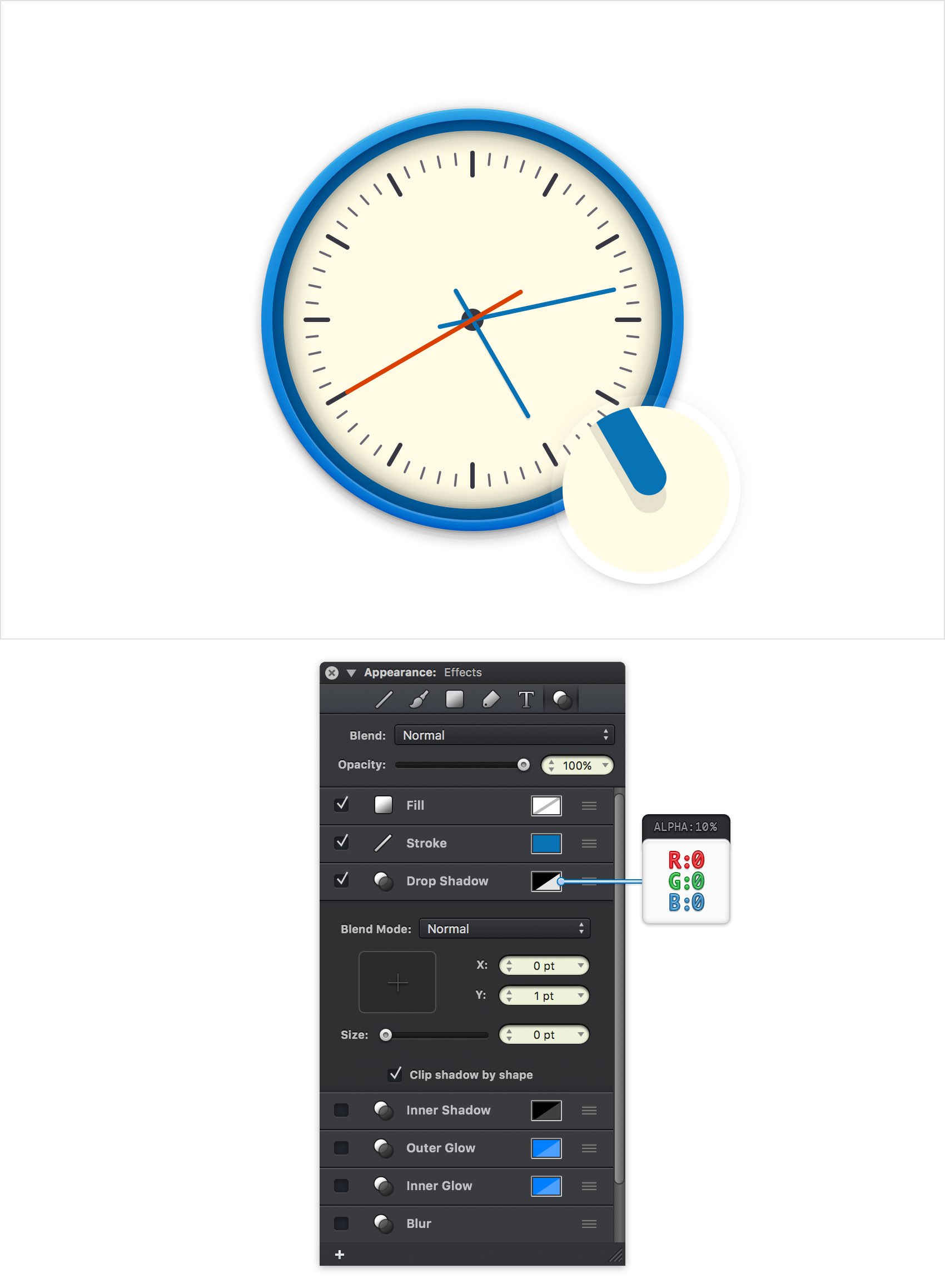
Step 34
Make sure that your hours hand path stays selected, focus on the Effects pane and duplicate the existing Drop Shadow. Select the new effect and enter the attributes shown in the following image.
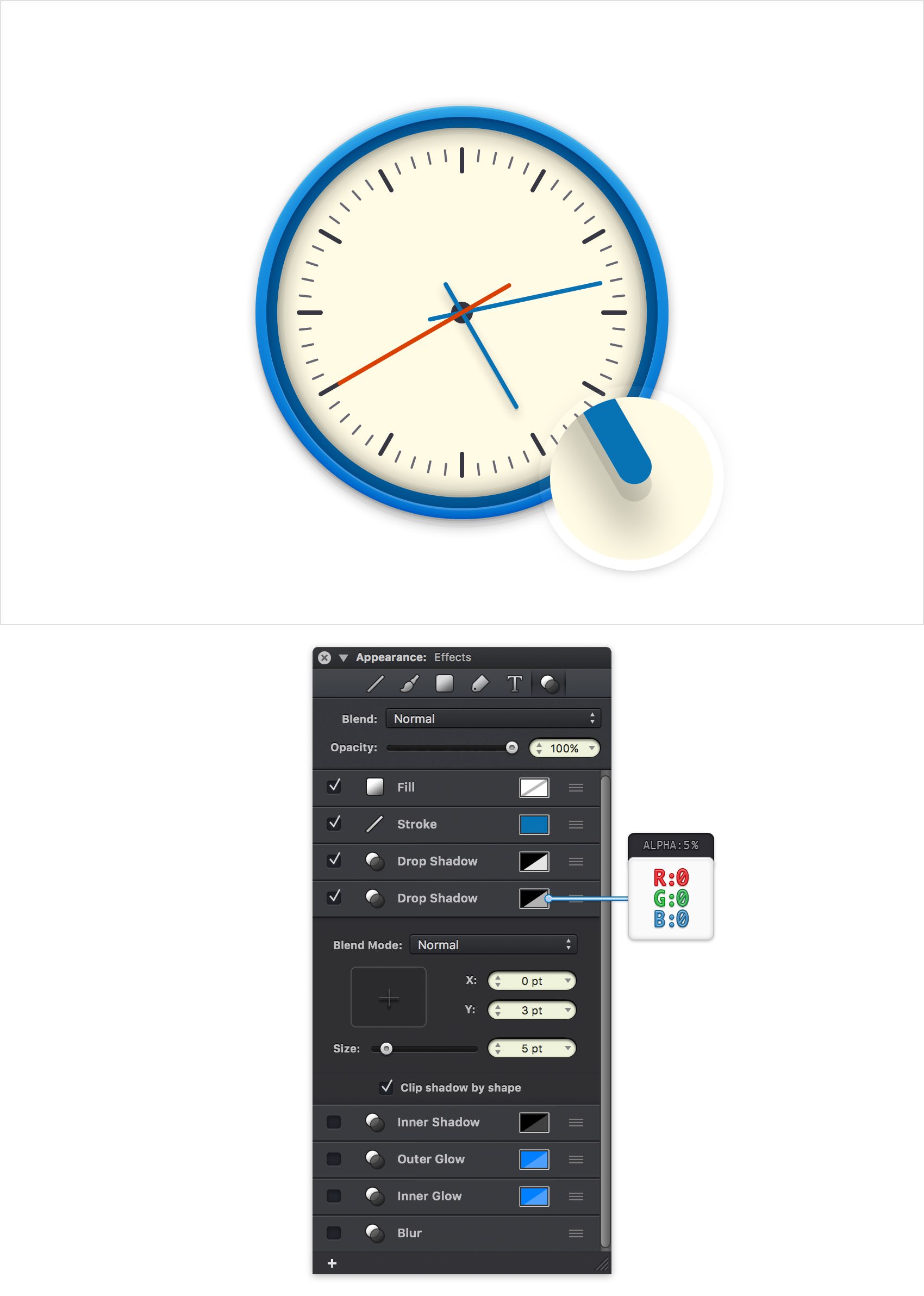
Step 35
Make sure that your hours hand path stays selected and focus on the Effects pane. Activate the existing Inner Shadow and enter the attributes shown in the following image.
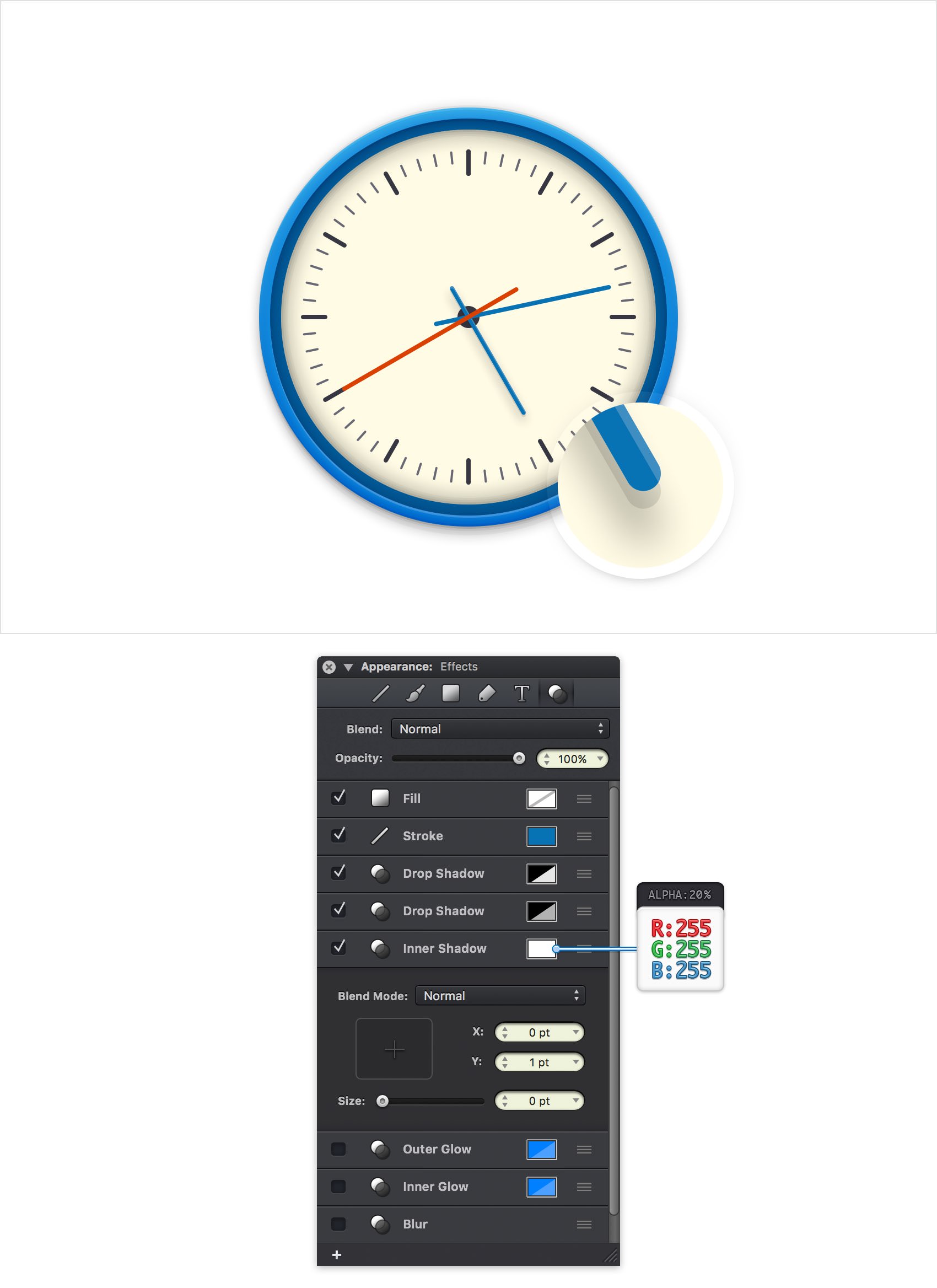
Step 36
Make sure that your hours hand path stays selected, focus on the Effects pane and duplicate the existing Inner Shadow. Select this new effect and enter the attributes shown in the following image.
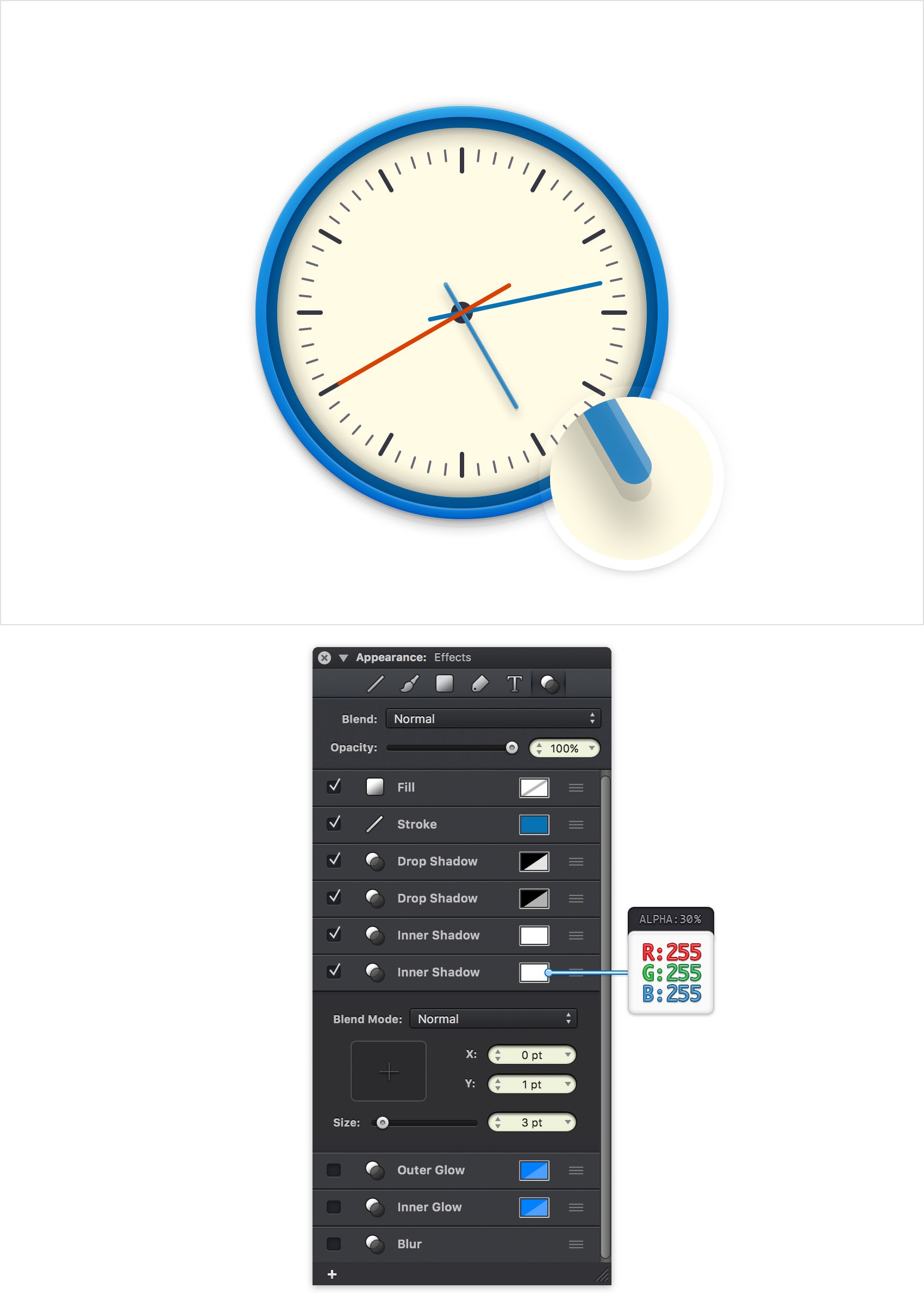
Step 37
Make sure that your hours hand path stays selected, focus on the Effects pane and duplicate the bottom Inner Shadow. Select this new effect **** and enter the attributes shown in the following image.
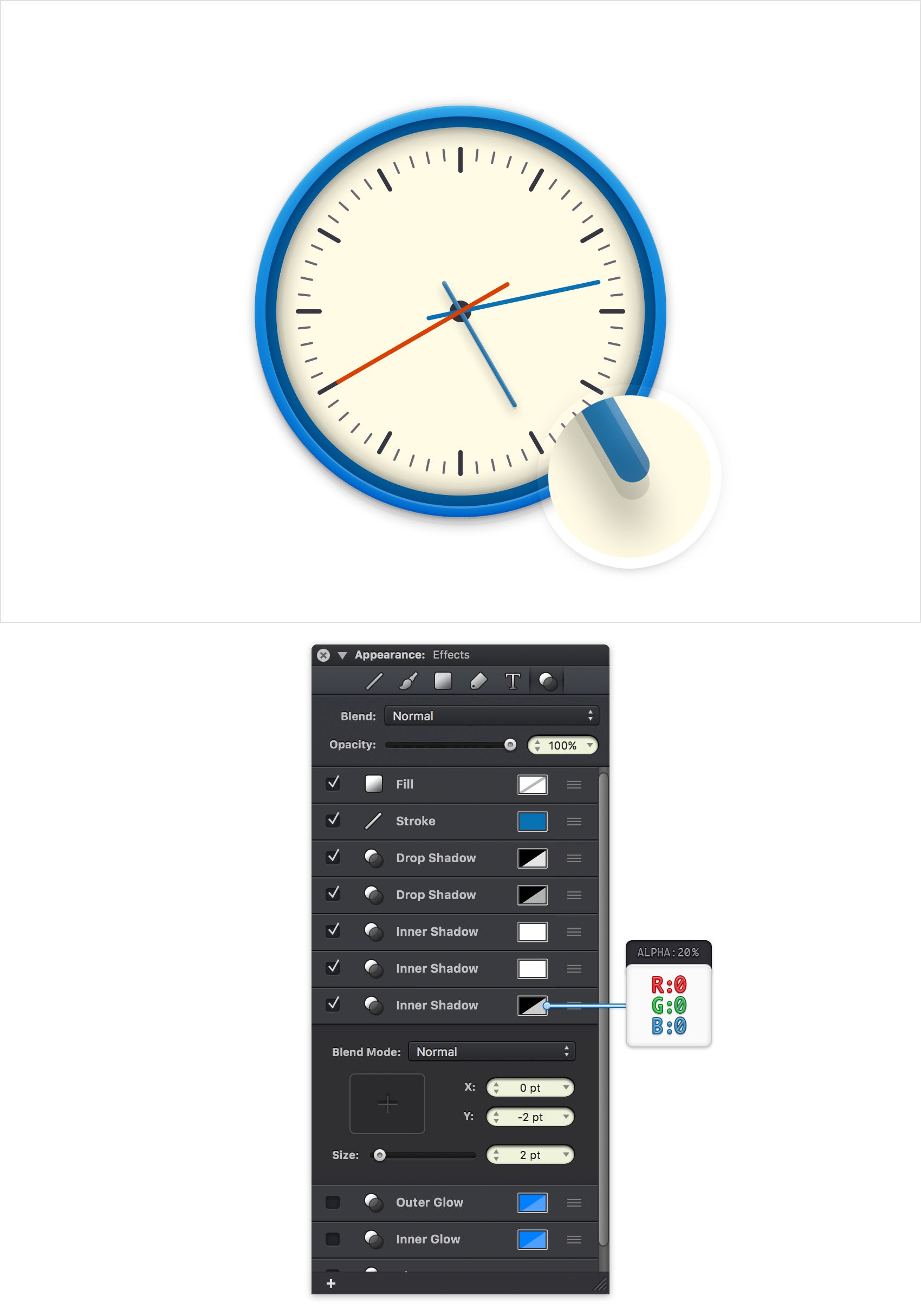
Step 38
Make sure that your hours hand path is still selected, right click anywhere on your canvas and go to Copy Style. Alternatively, you can use the Alt + Command + C keyboard shortcut. Move to the blue path that makes up your minutes hand path, right click again and this time go to Paste Style (or use the Alt + Command + V keyboard shortcut).
Make sure that your minutes hand path stays selected, focus on the Effects pane and duplicate the top Drop Shadow effect. Select the newly added effect, make sure that it lies between the other two Drop Shadows and then enter the attributes shown in the following image.
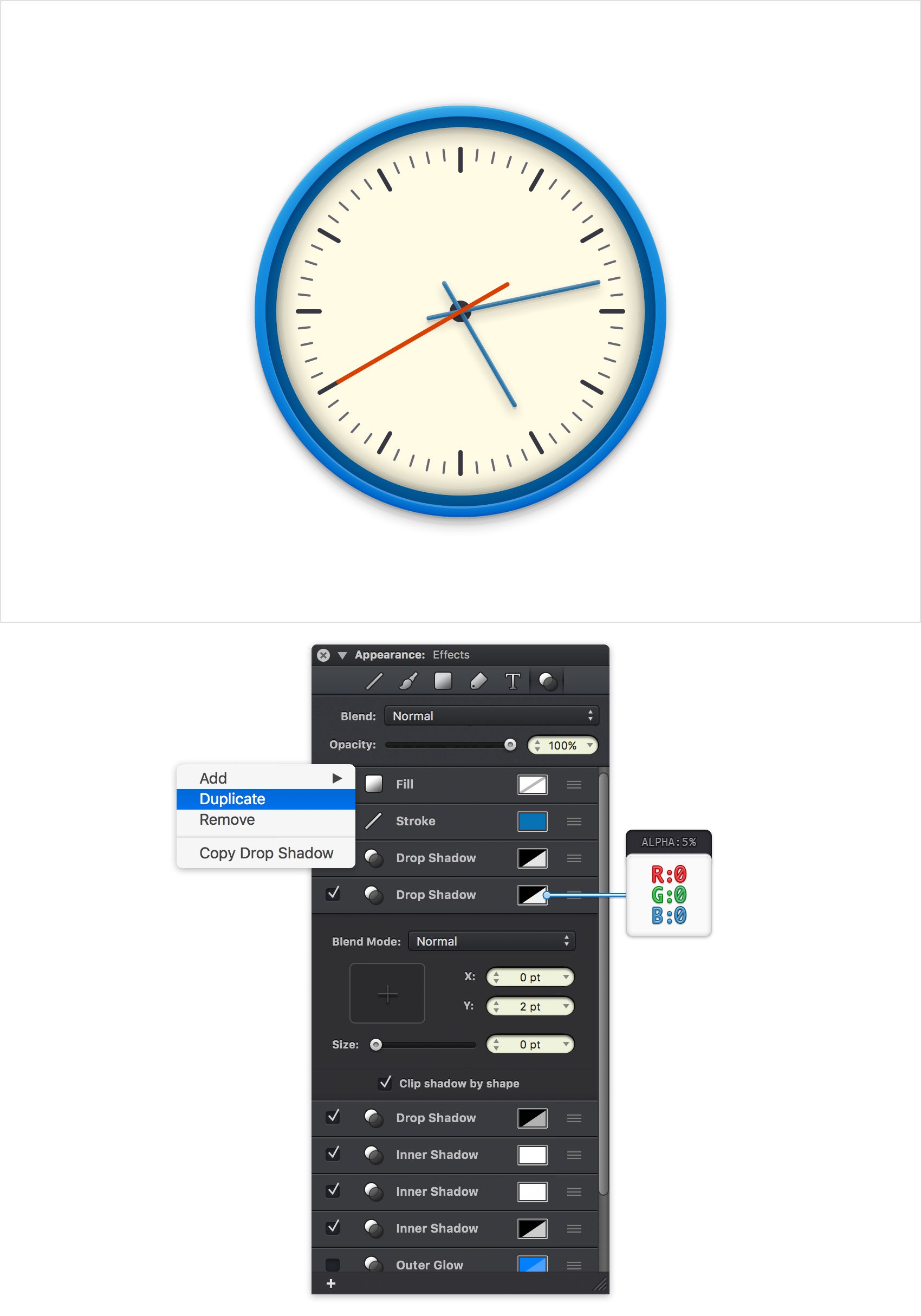
Step 39
Make sure that your minutes hand path is still selected and copy the style (Alt + Command + C). Select the path that makes up your seconds hand and paste the style (Alt + Command + V).
Make sure that your seconds hand path stays selected and focus on the Effects pane. First, remove the two, bottom Inner Shadows and then select that Stroke and replace the existing color with R=219 G=65 B=0. In the end things should look like in the following image.
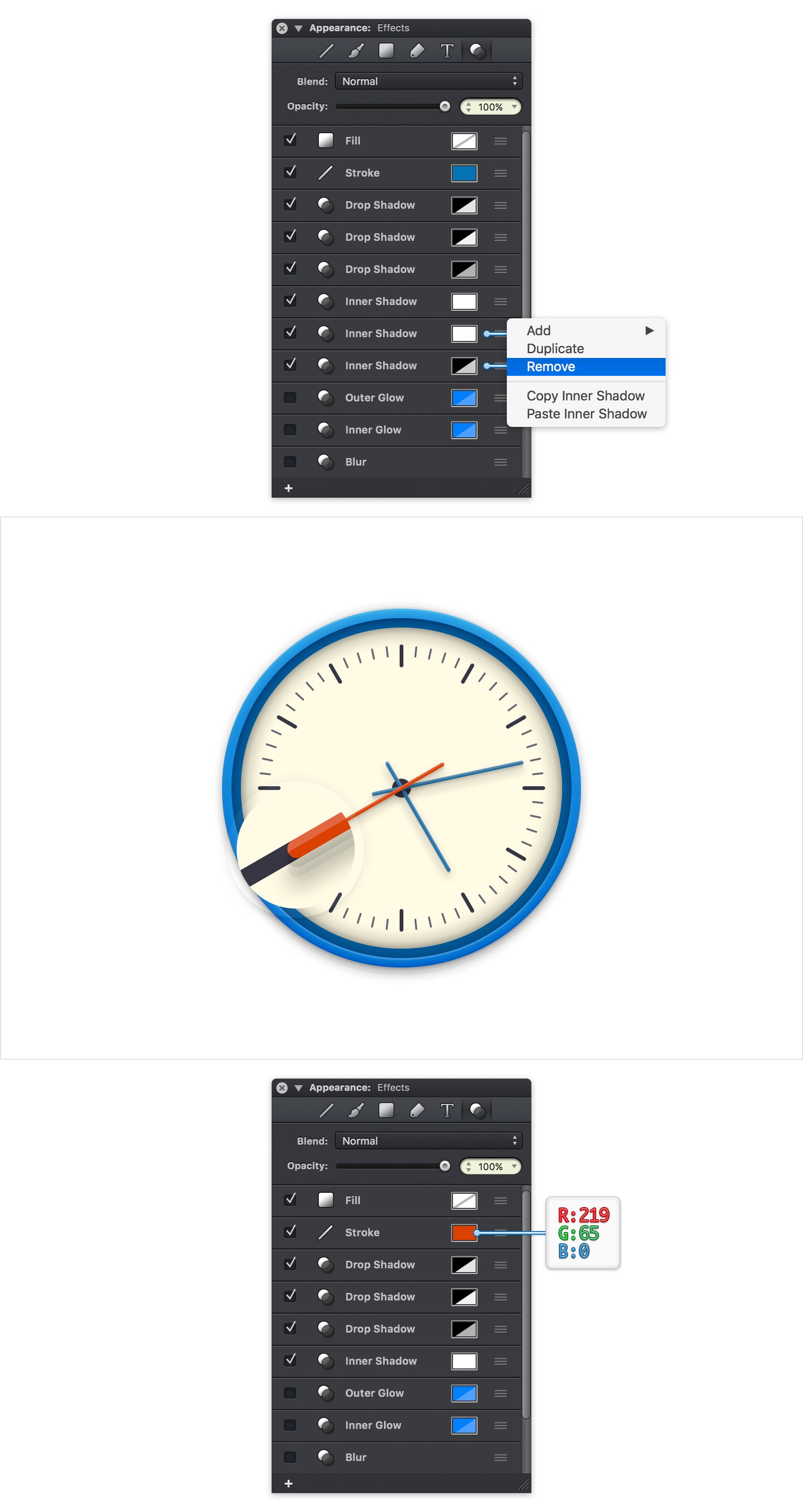
Step 40
Select your tiny, dark circle and hit Shift + Control + ] to bring it to front. Make sure that this shape stays selected and focus on the Effects pane. Activate the existing Drop Shadow and enter the attributes shown in the following image.
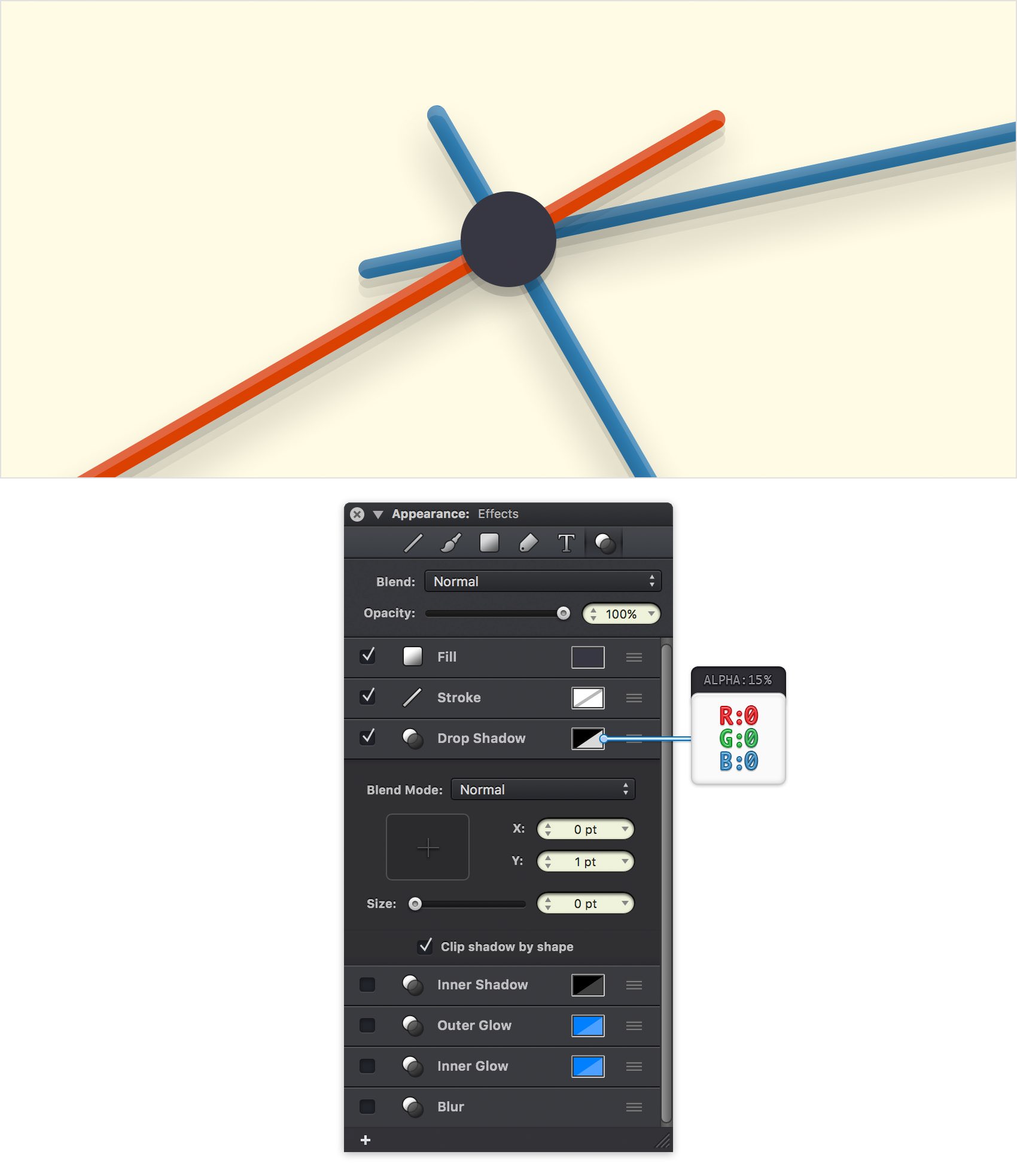
Step 41
Make sure that your tiny circle stays selected, focus on the Effects pane and duplicate the existing Drop Shadow. Select the new effect**** and enter the attributes shown in the following image.
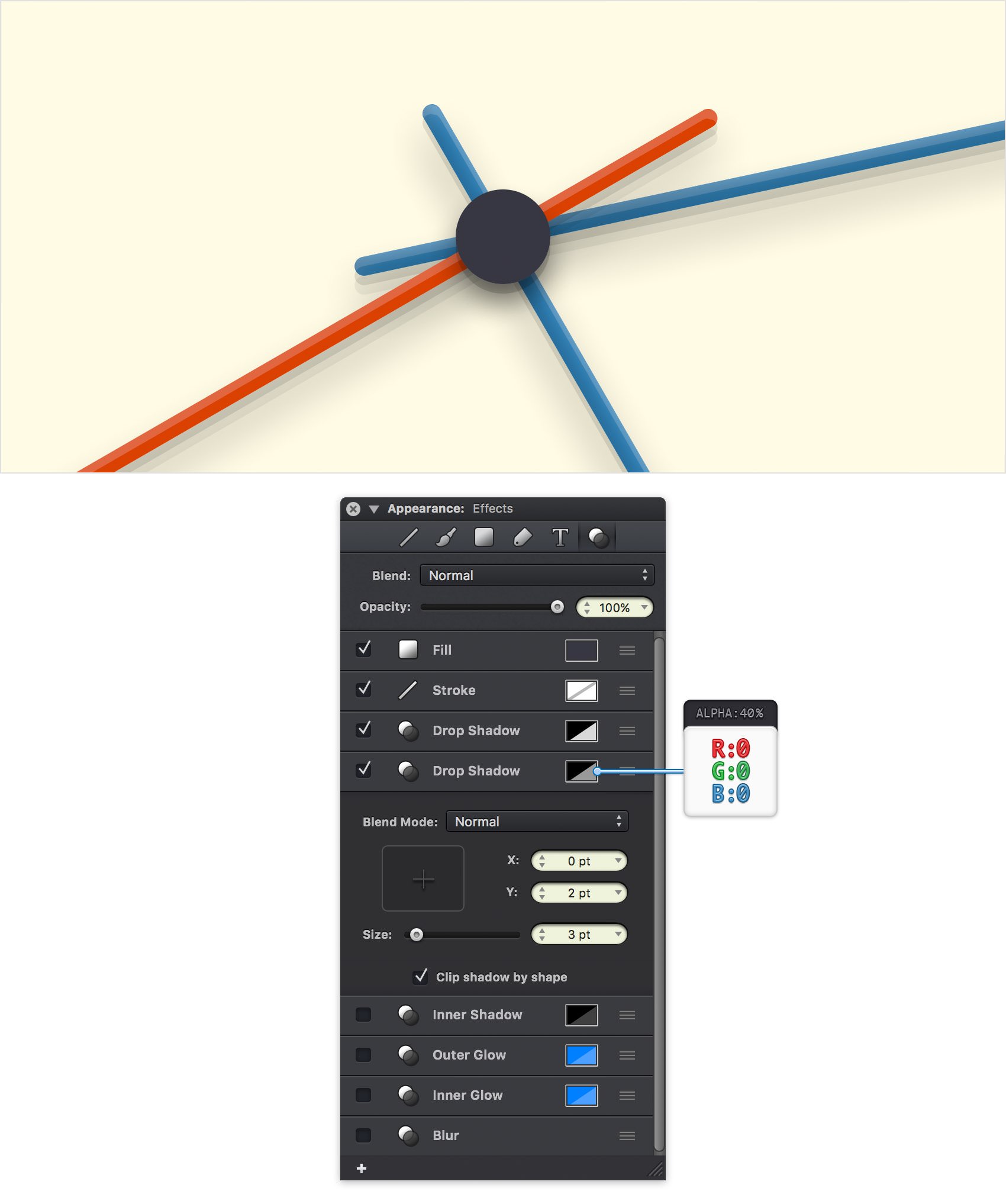
Step 42
Make sure that your tiny circle stays selected and keep focusing on the Effects pane. Activate the existing Inner Shadow and enter the attributes shown in the following image.
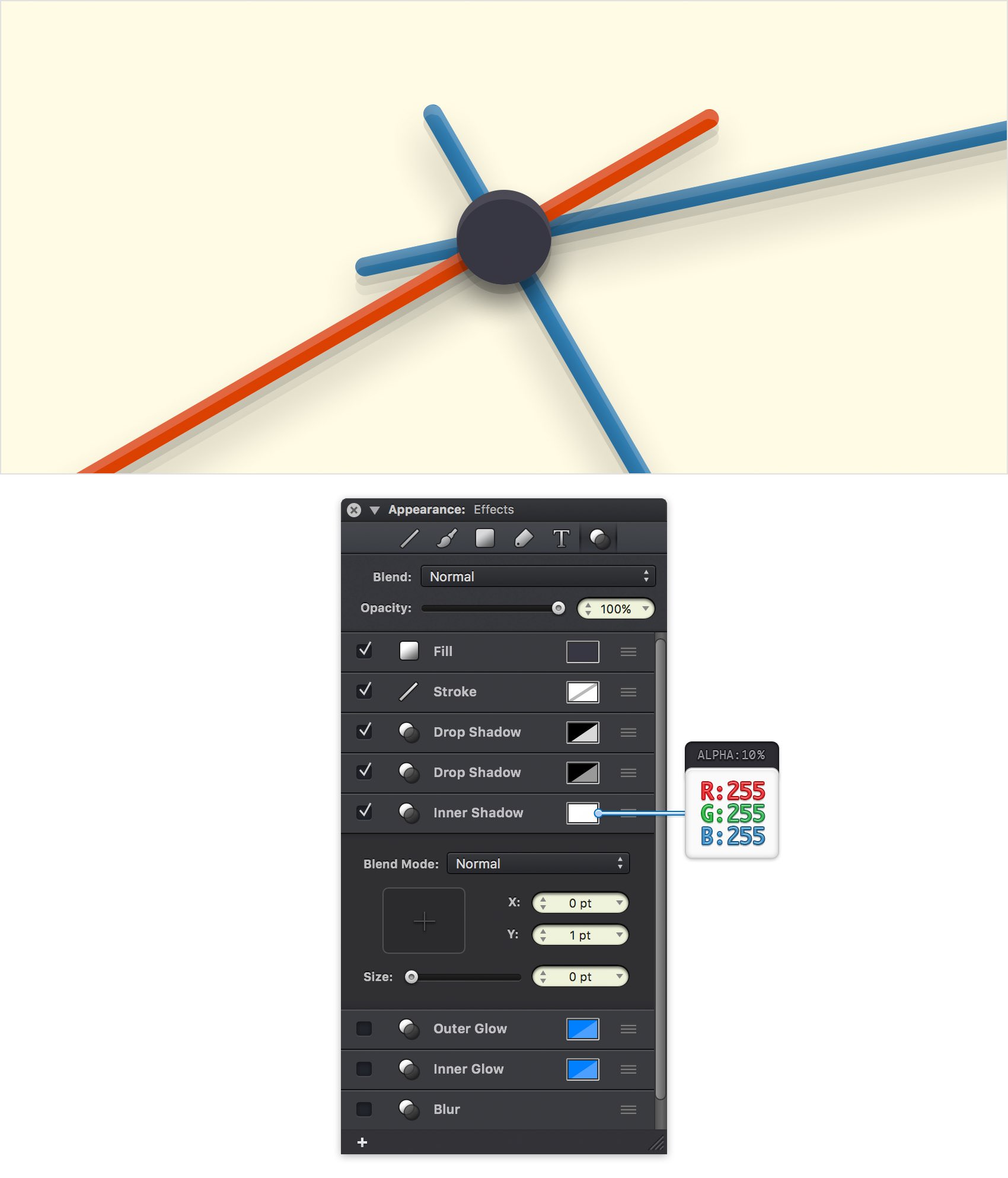
Step 43
Make sure that your tiny circle stays selected, focus on the Effects pane and duplicate the existing Inner Shadow. Select the new effect**** and enter the attributes shown in the following image.
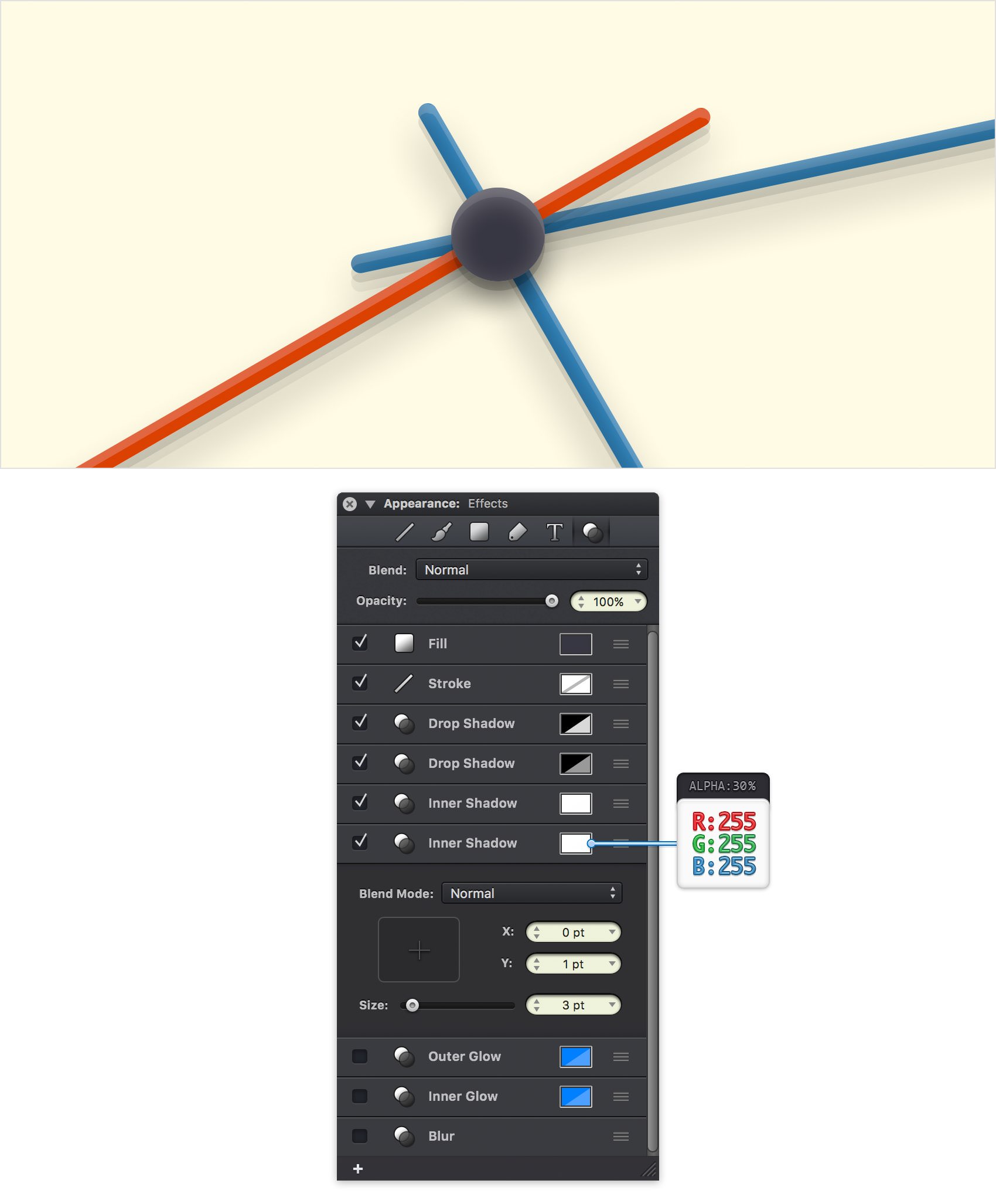
Step 44
Make sure that your tiny circle stays selected, focus on the Effects pane and duplicate the bottom Inner Shadow. Select the new effect**** and enter the attributes shown in the following image.
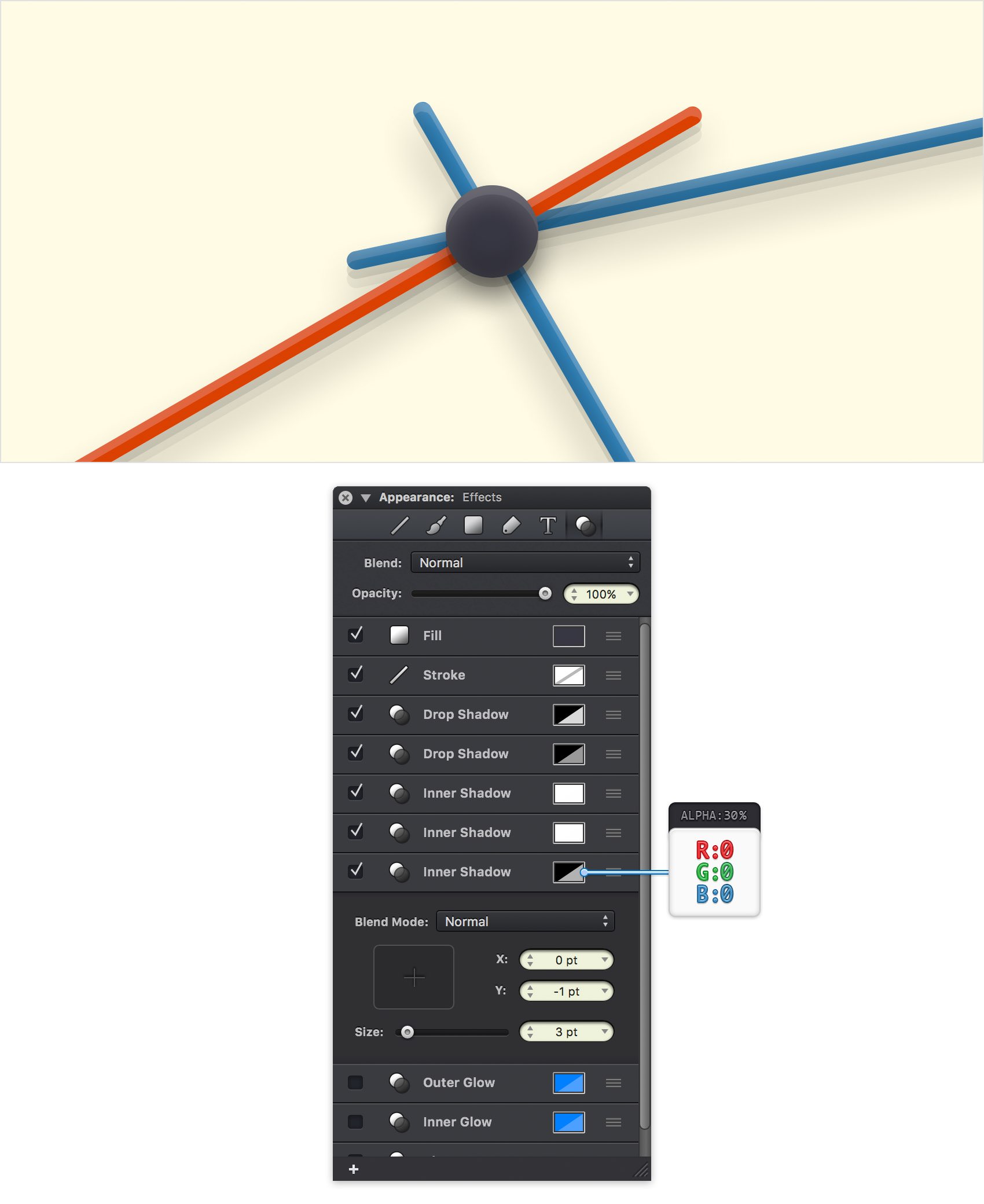
Finished Design
Congratulations, you've finished the tutorial!
Hope you've enjoyed learning some of the techniques and processes presented in these steps. As always, feel free to adjust the final design and make it your own.

Download Graphic File:
clockillustration.idraw 


